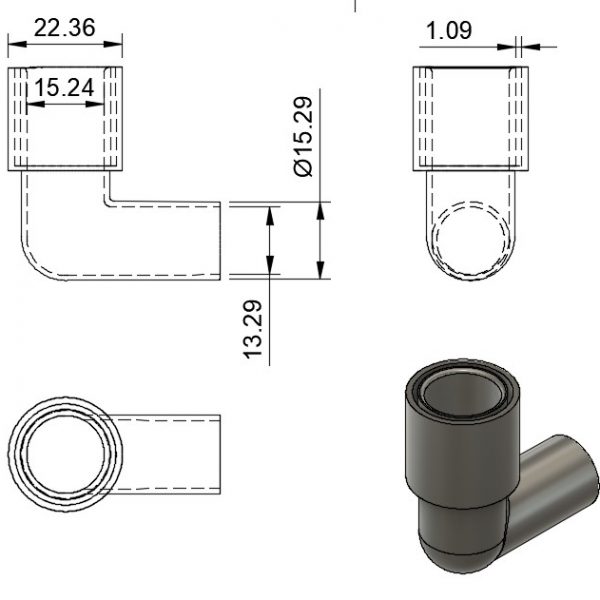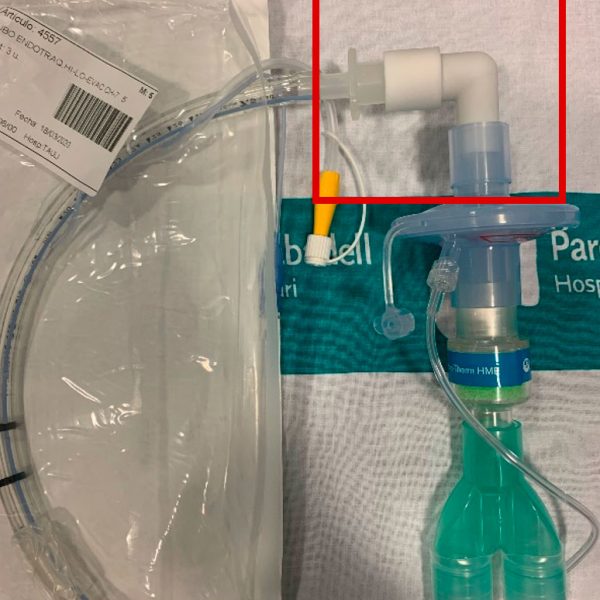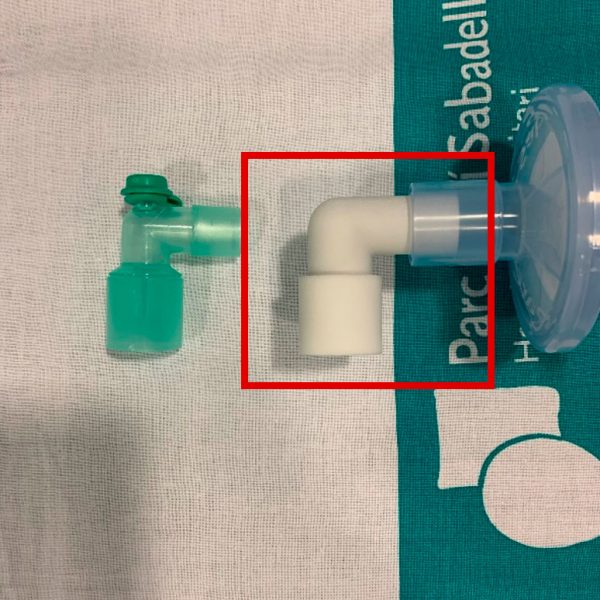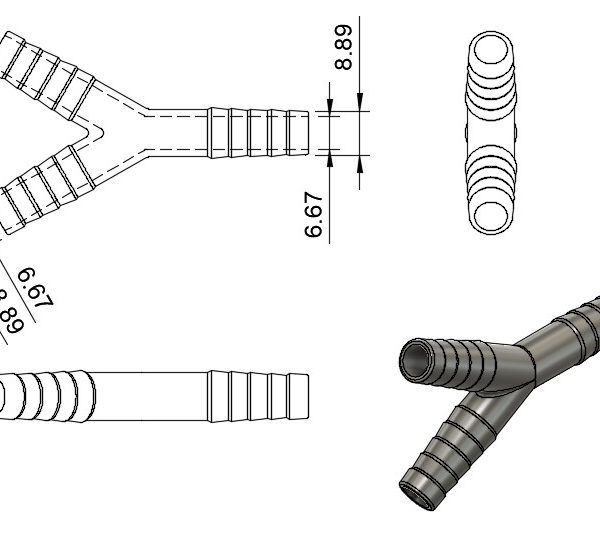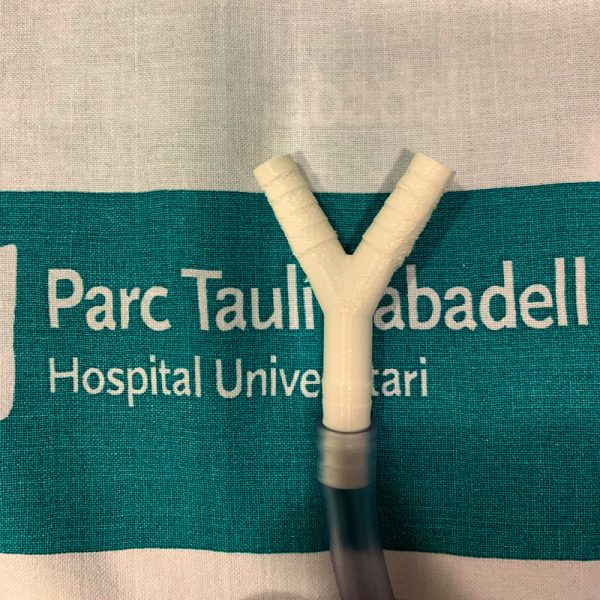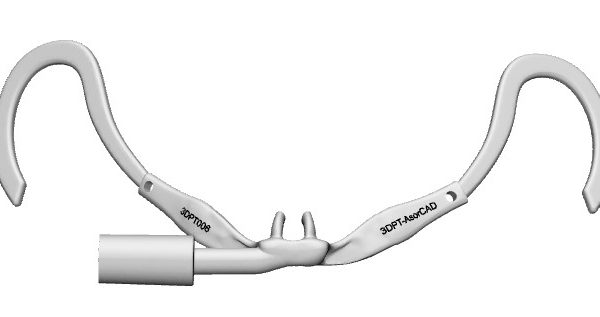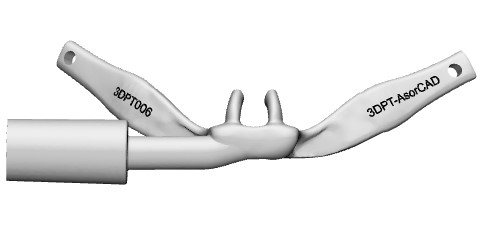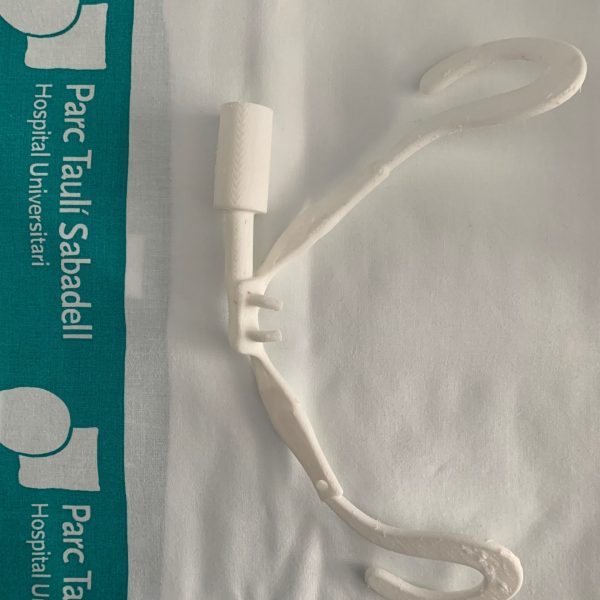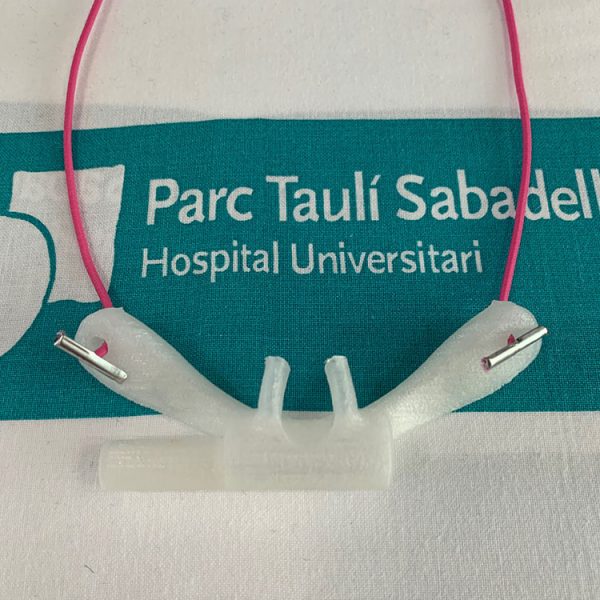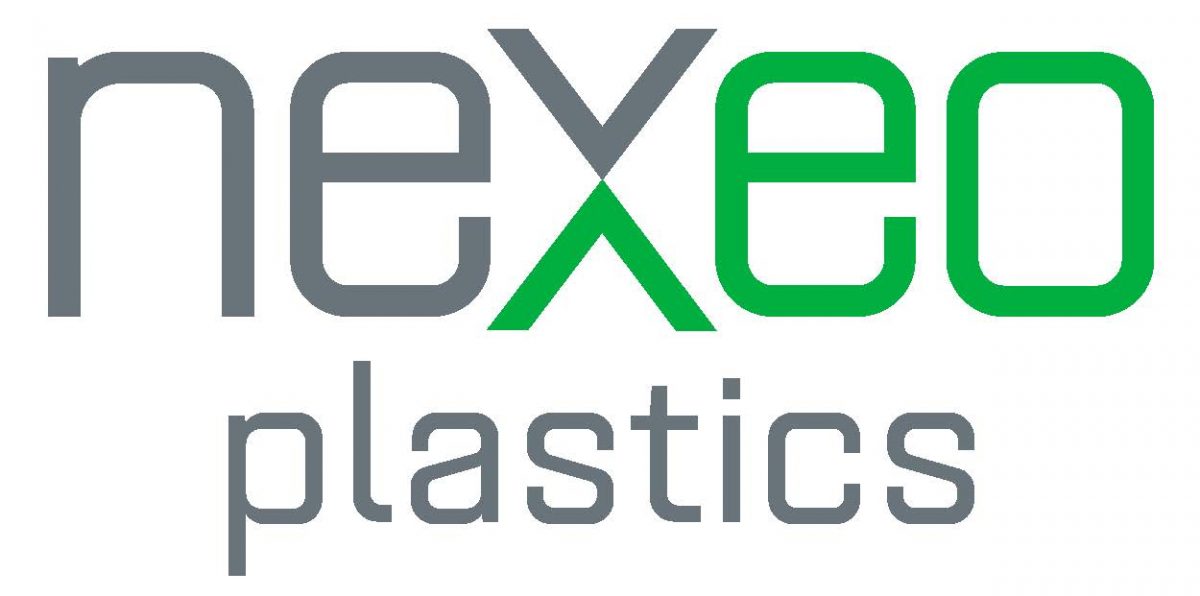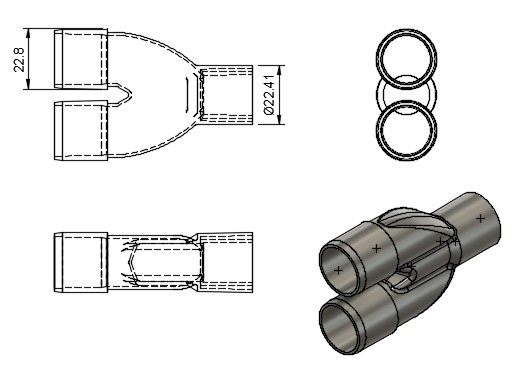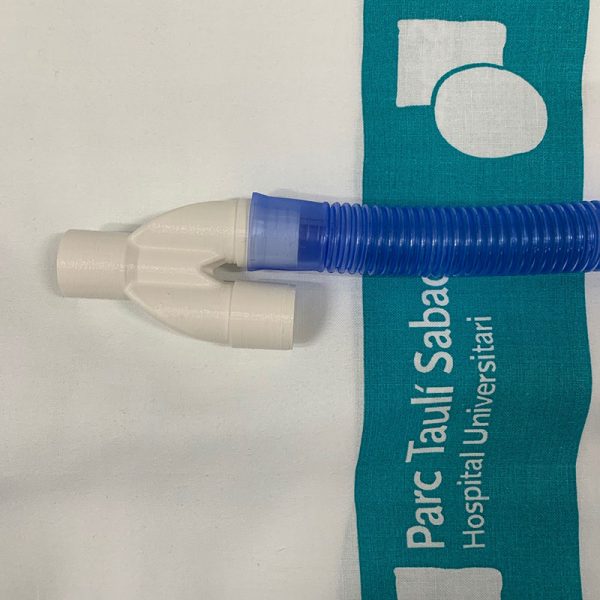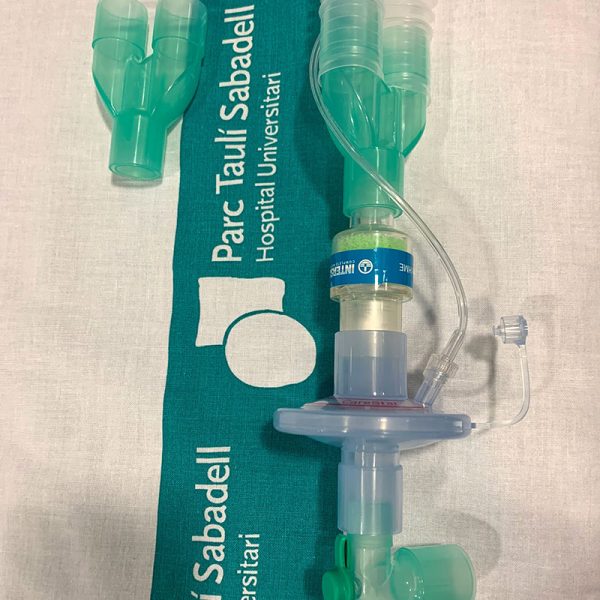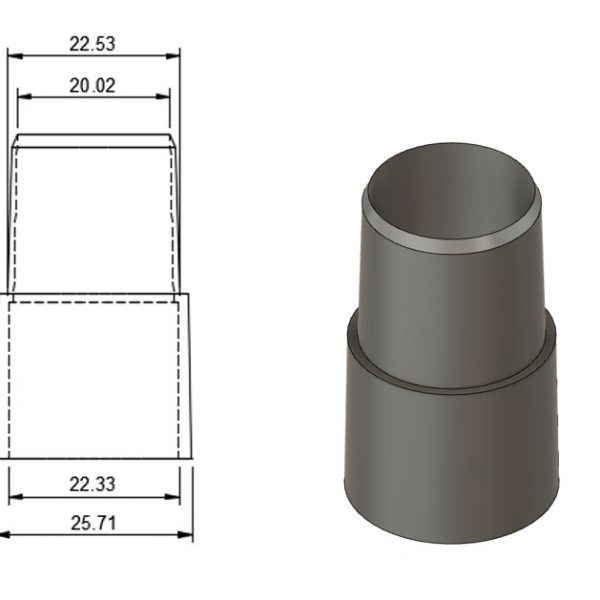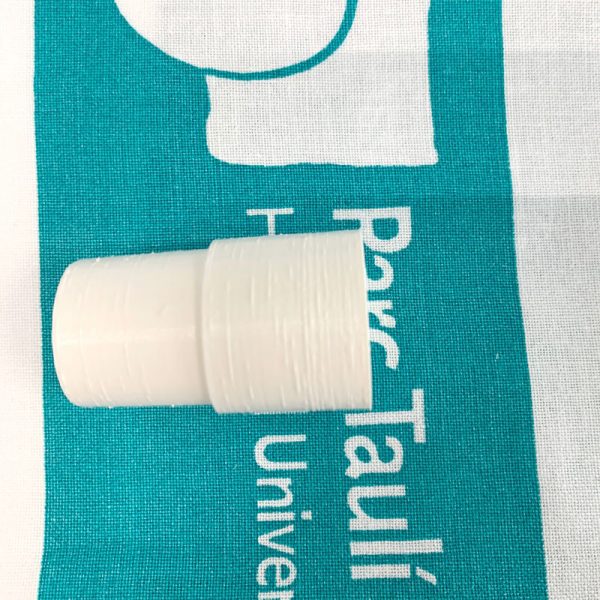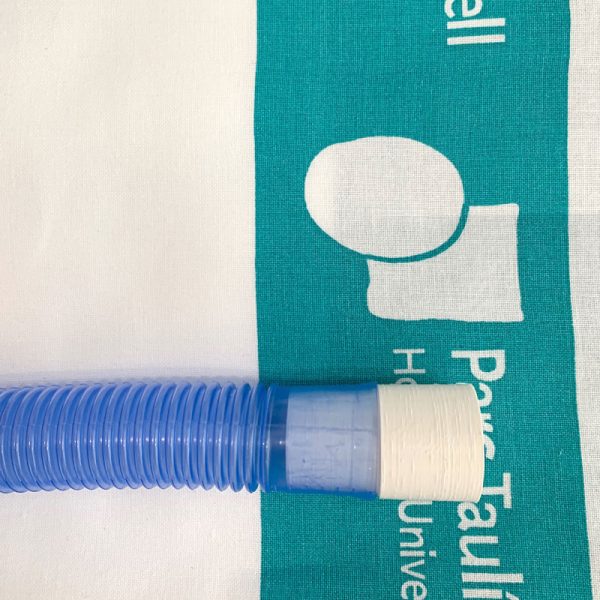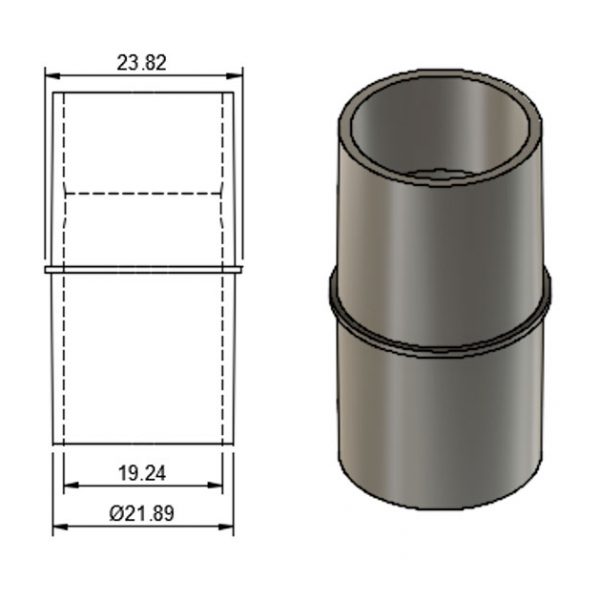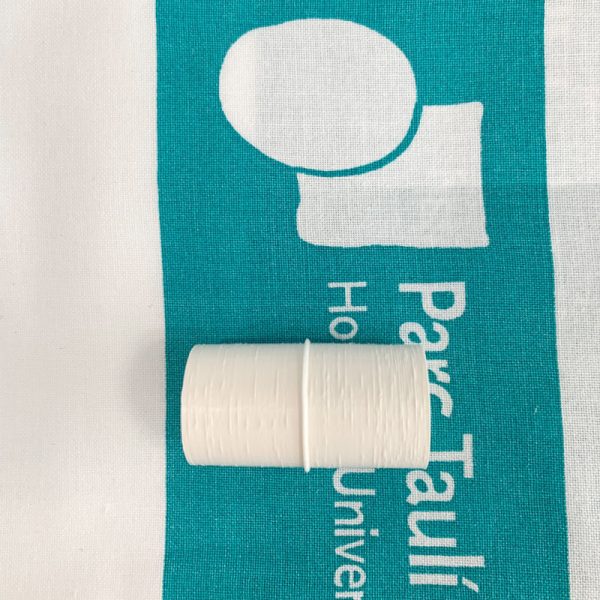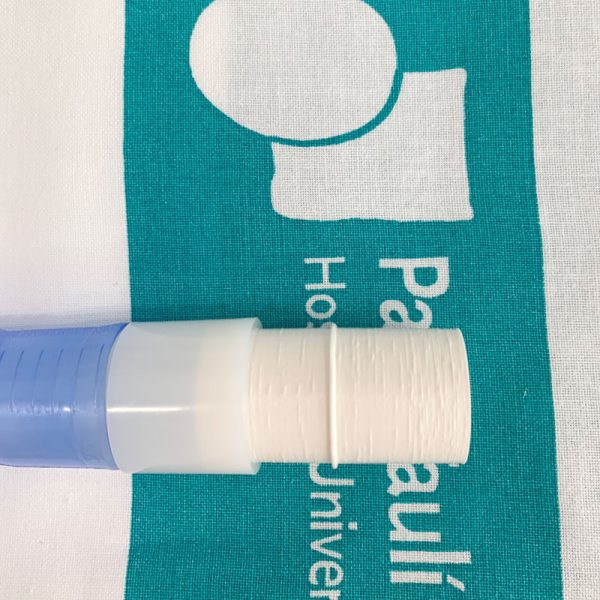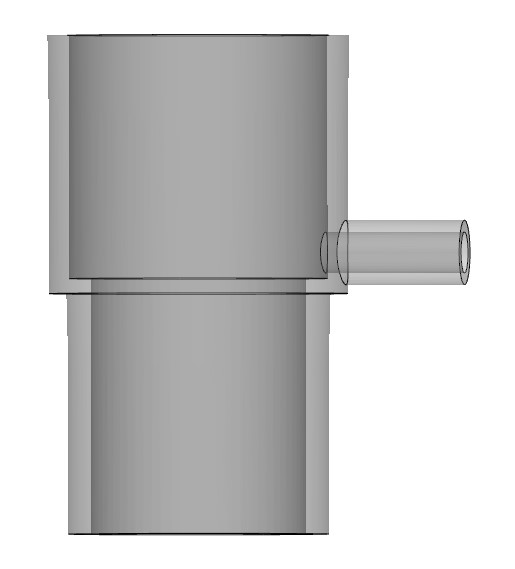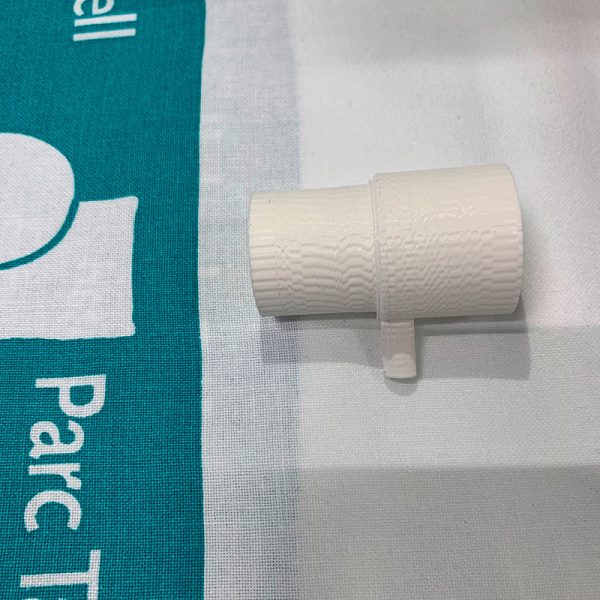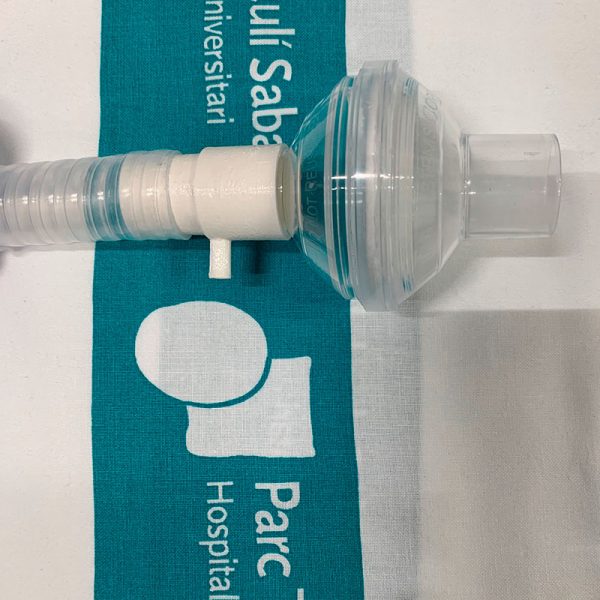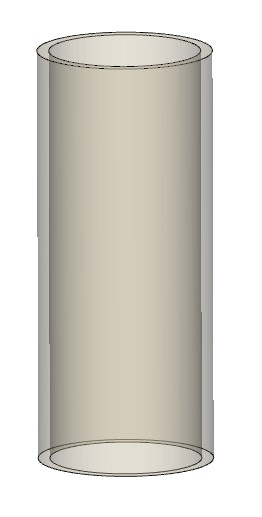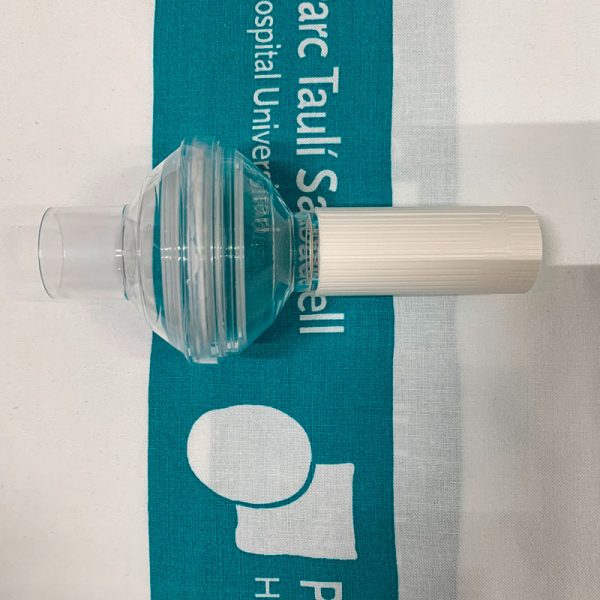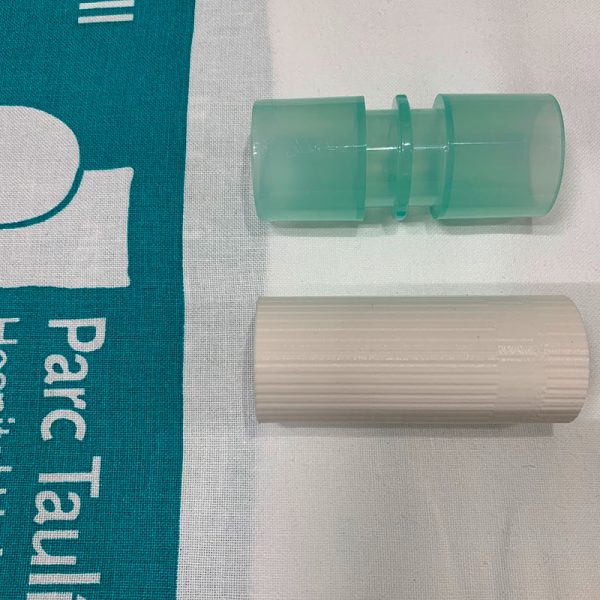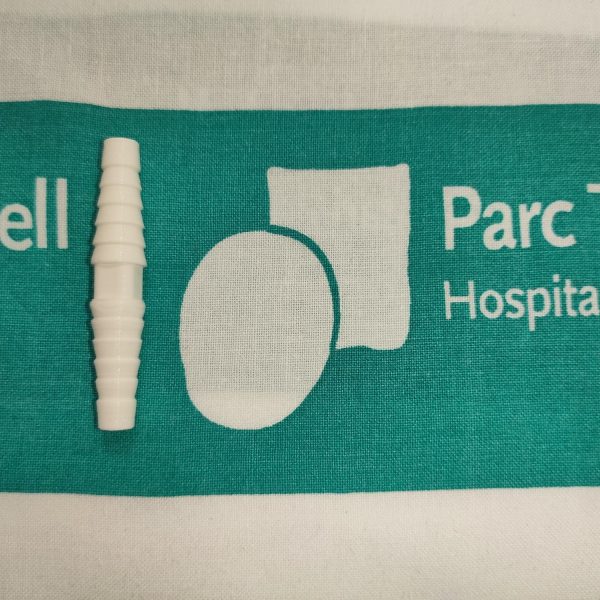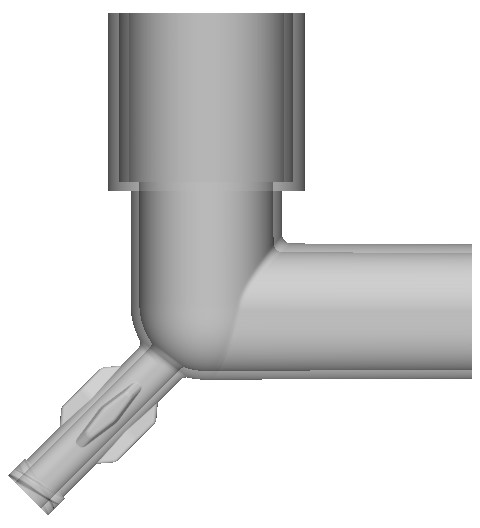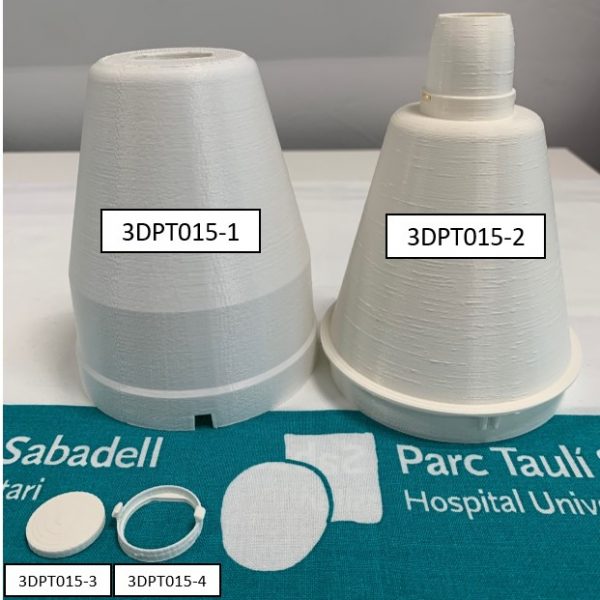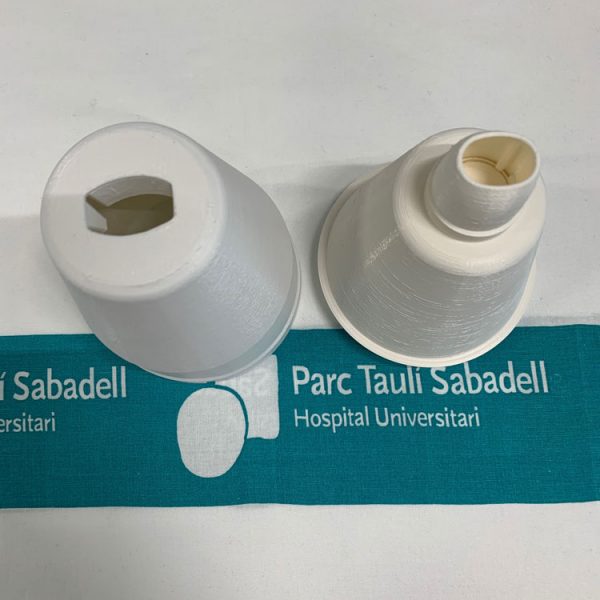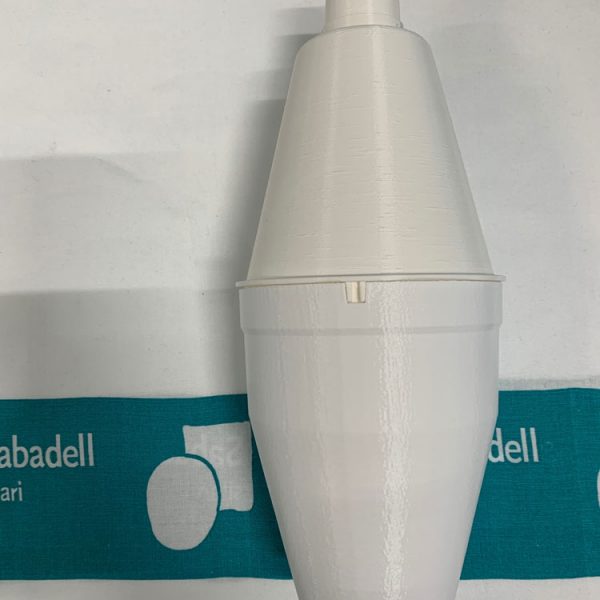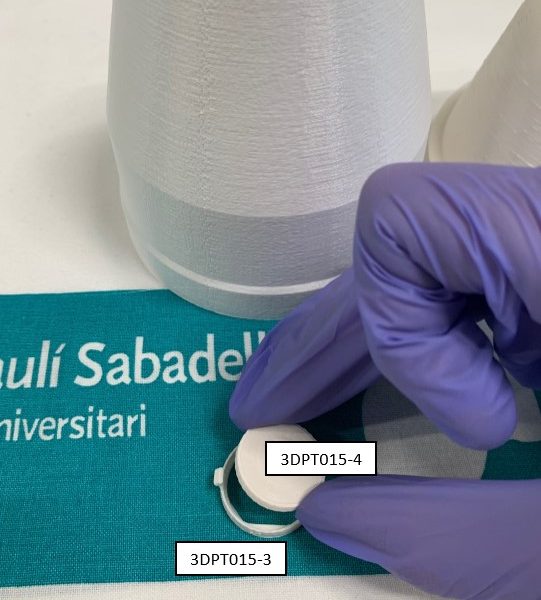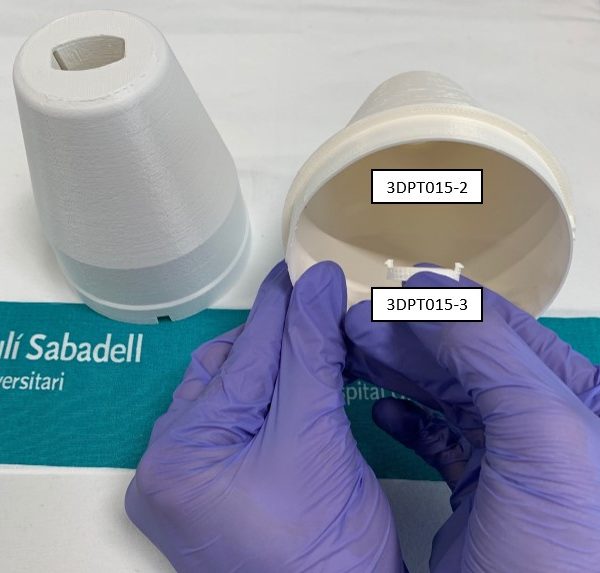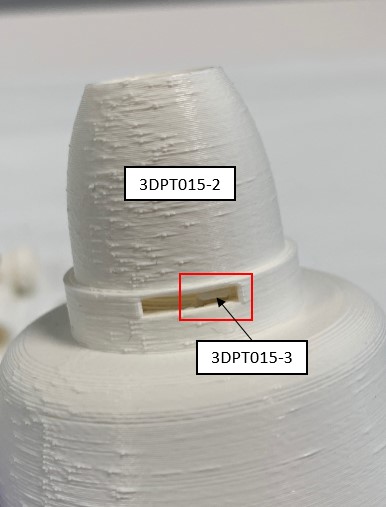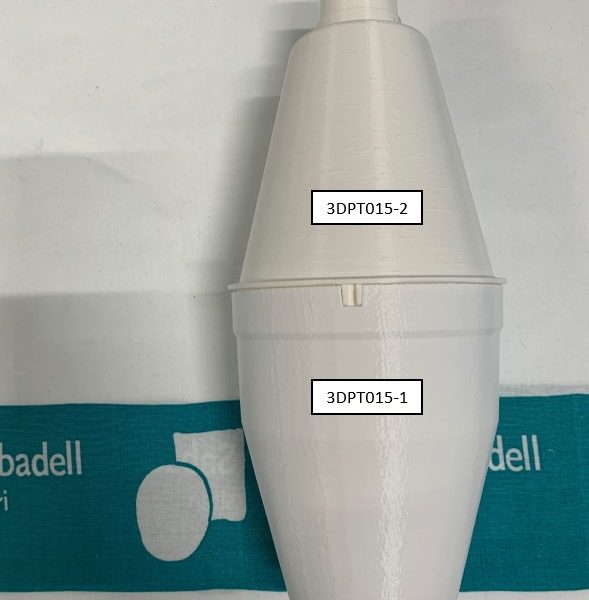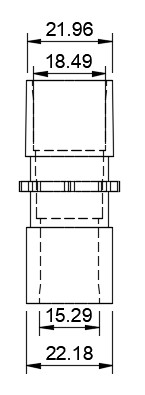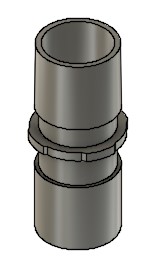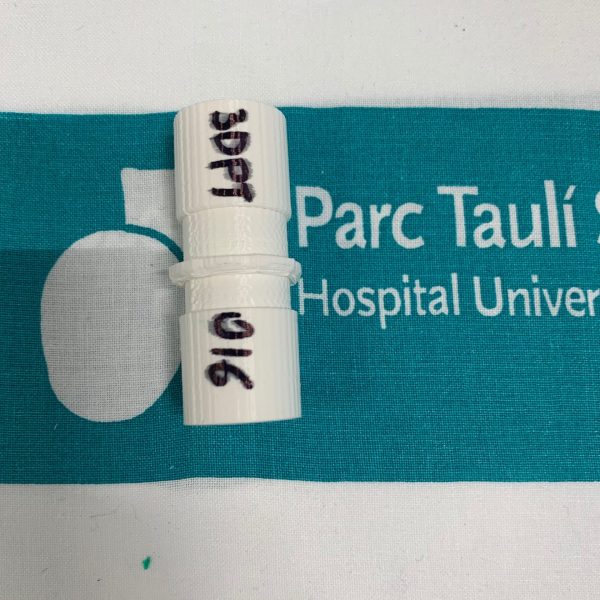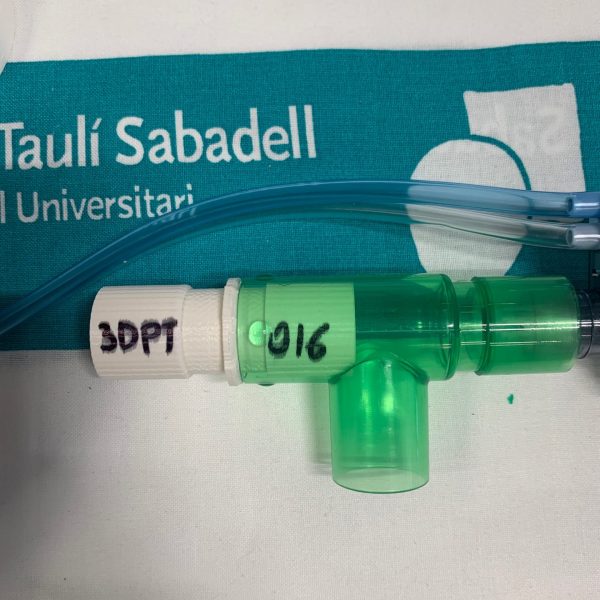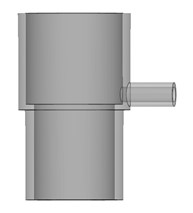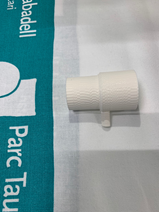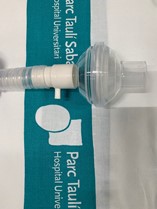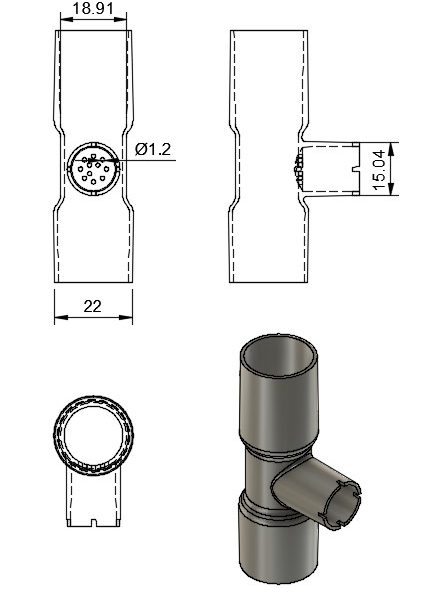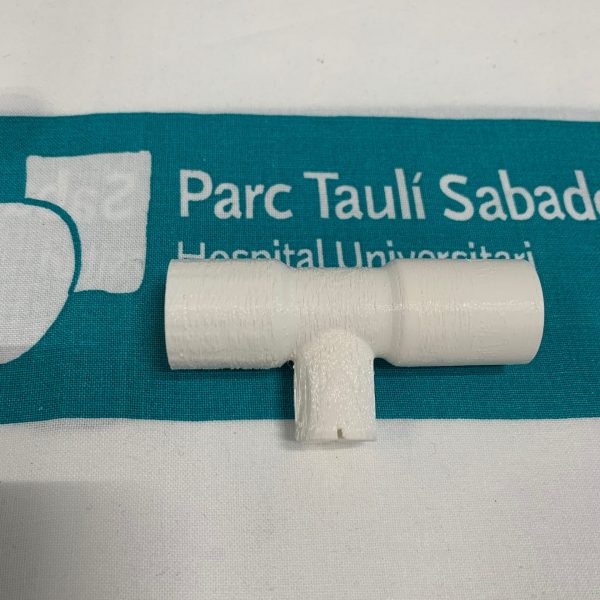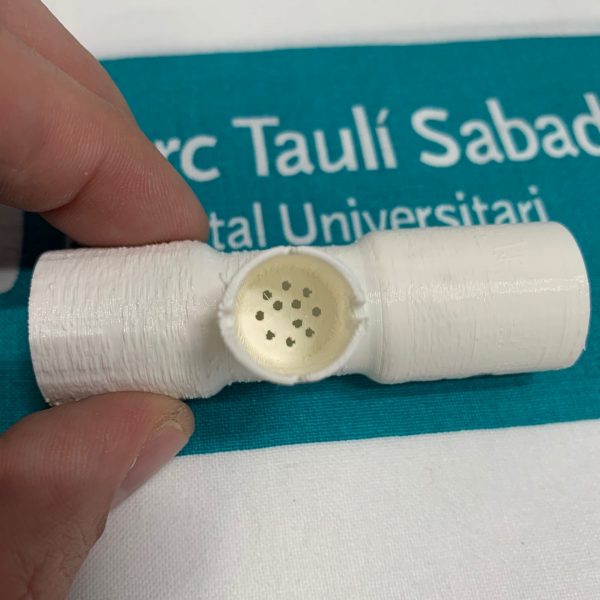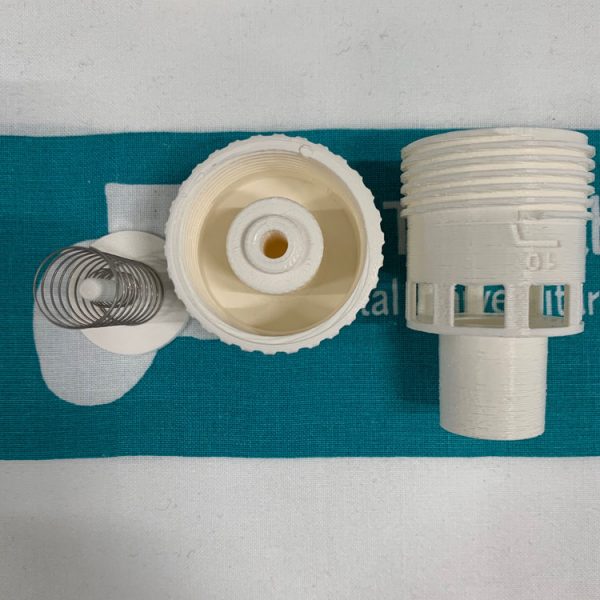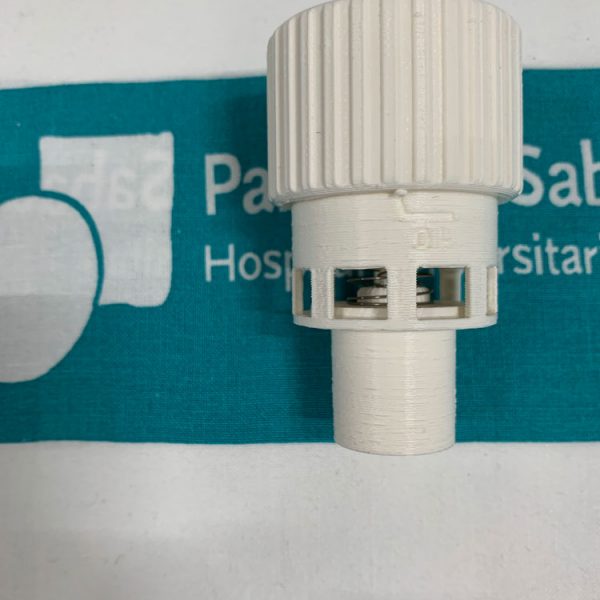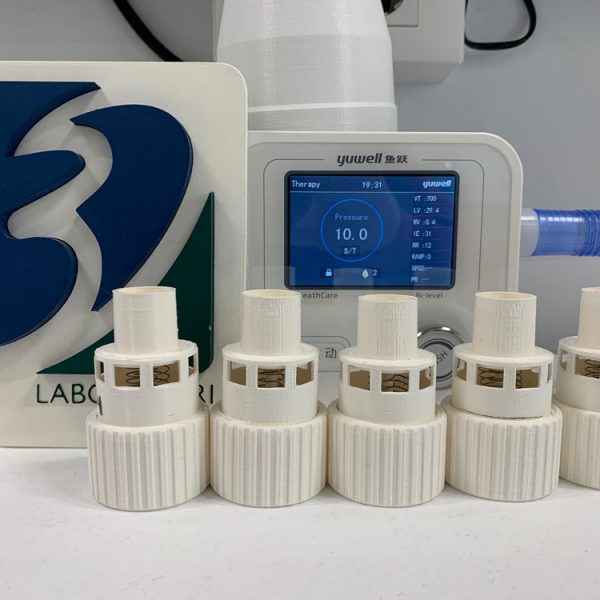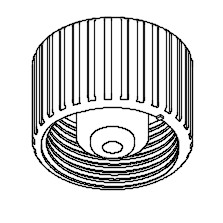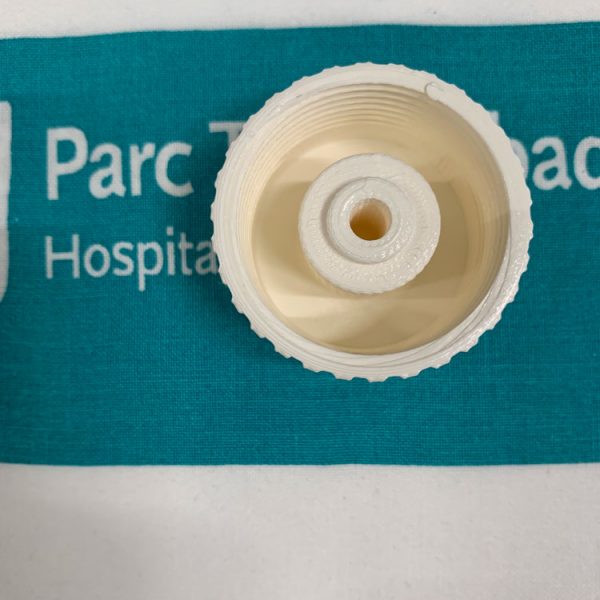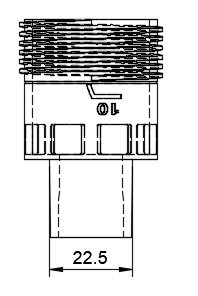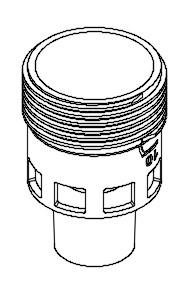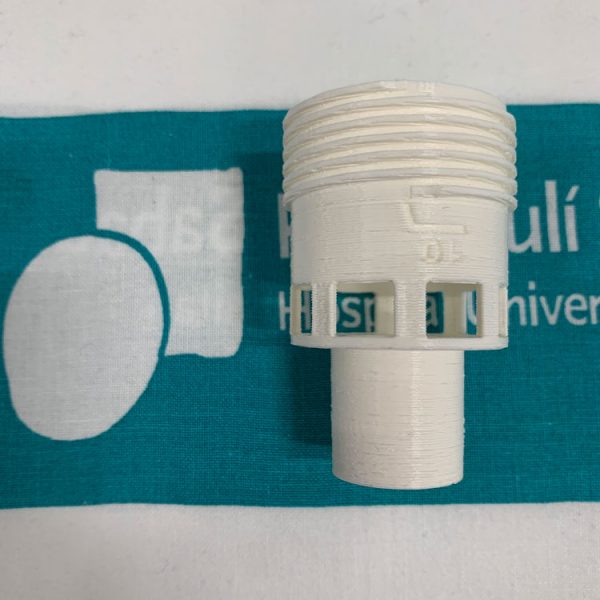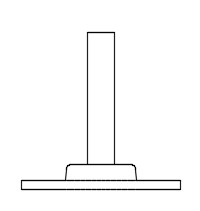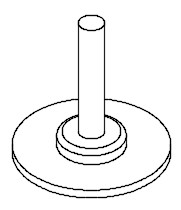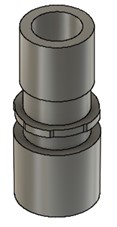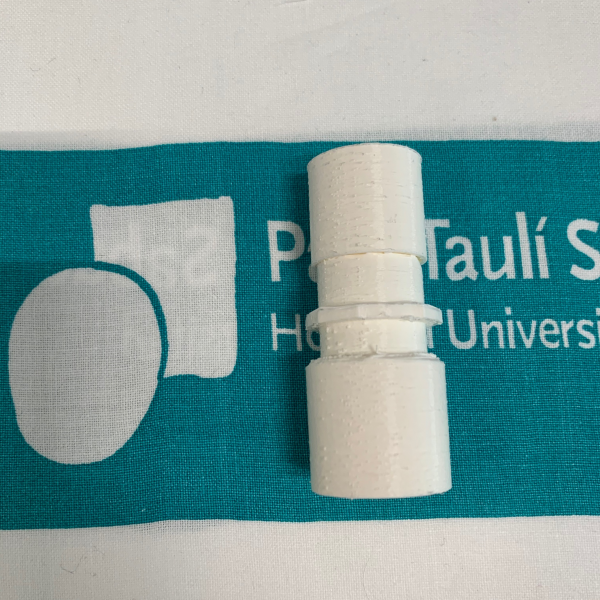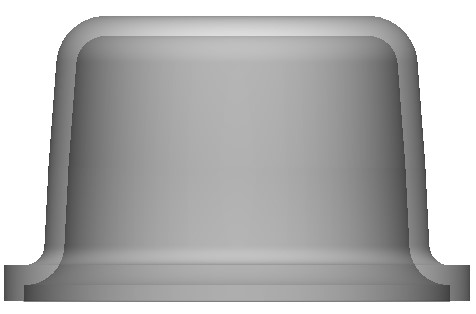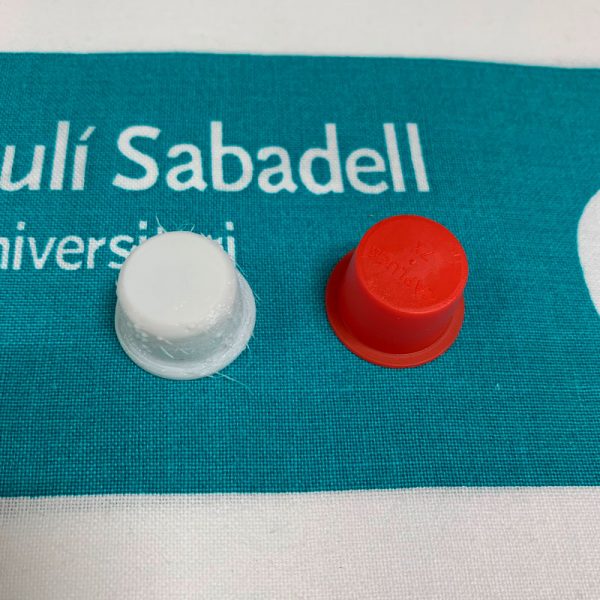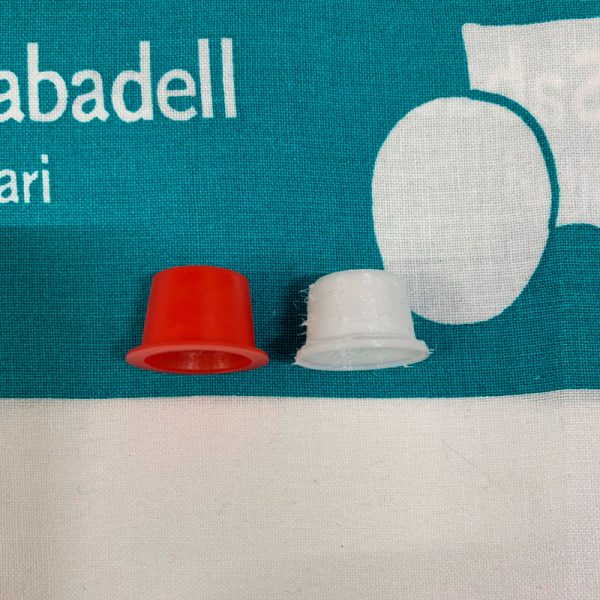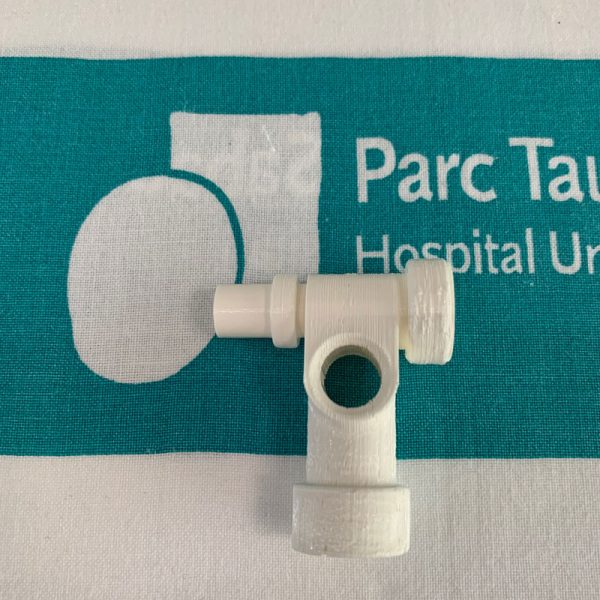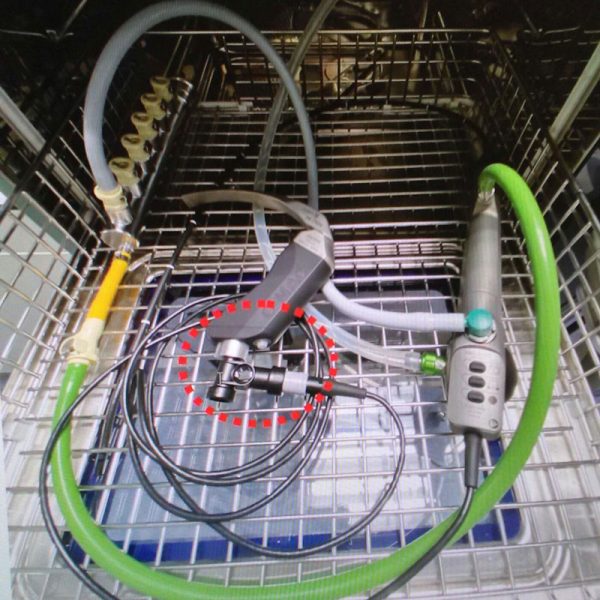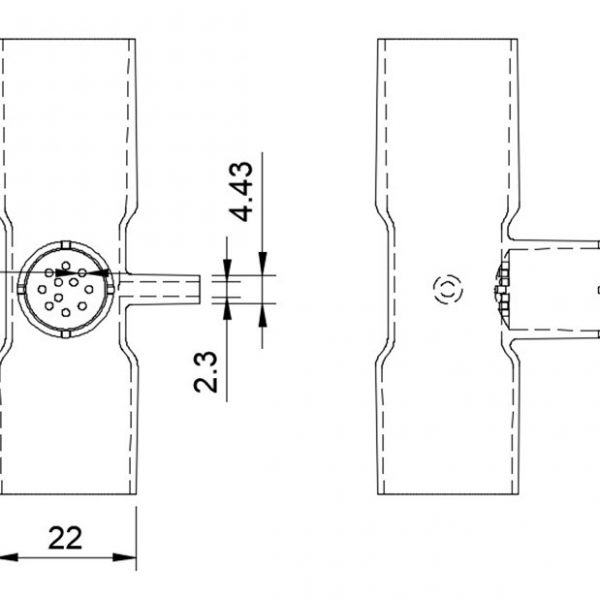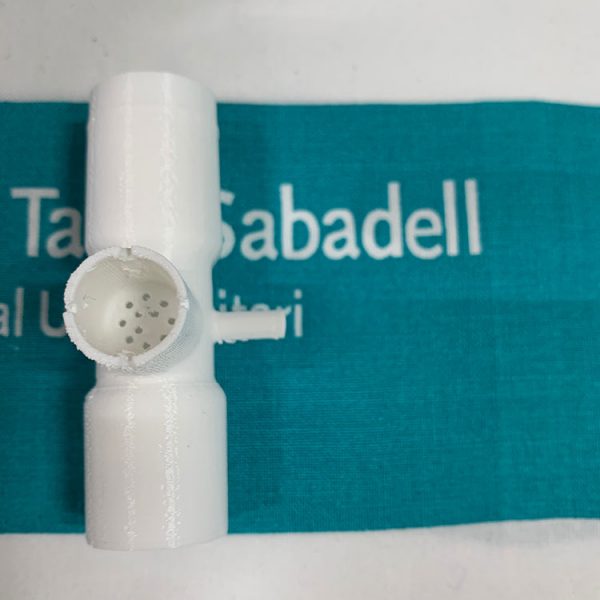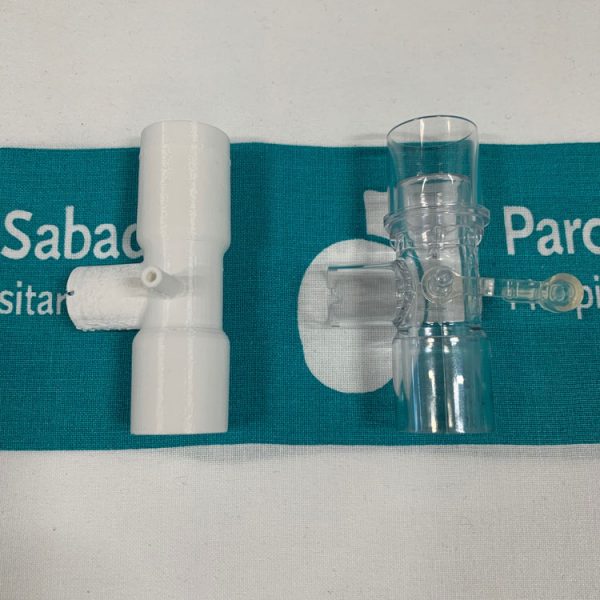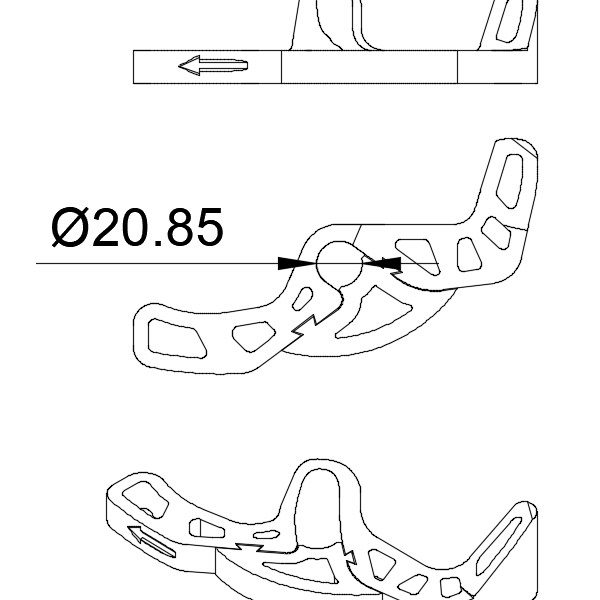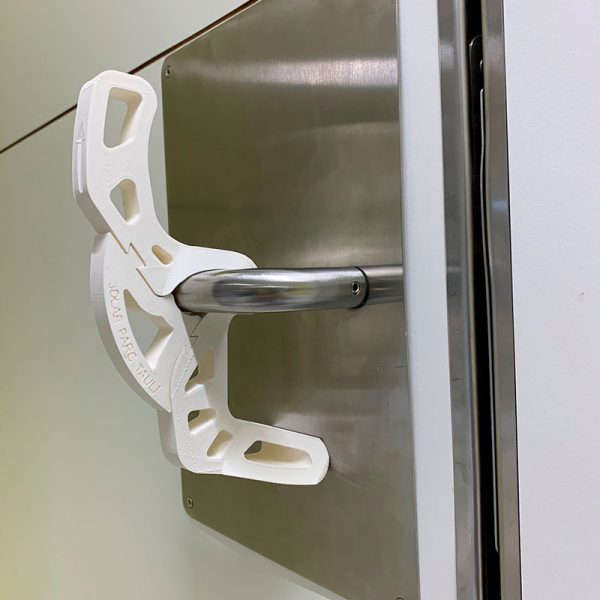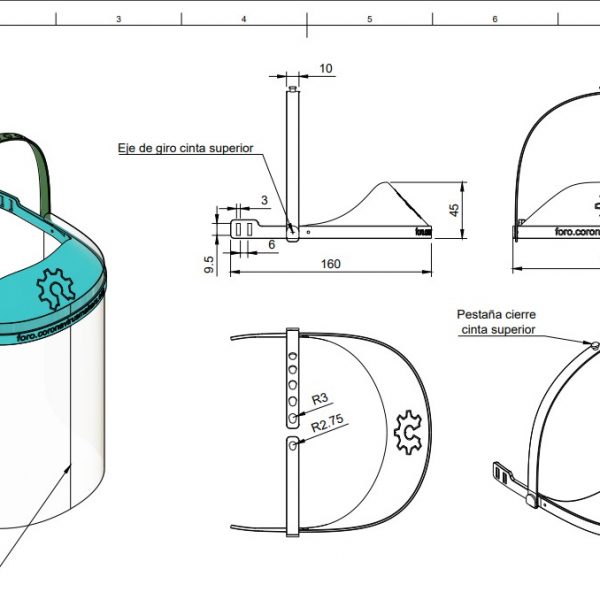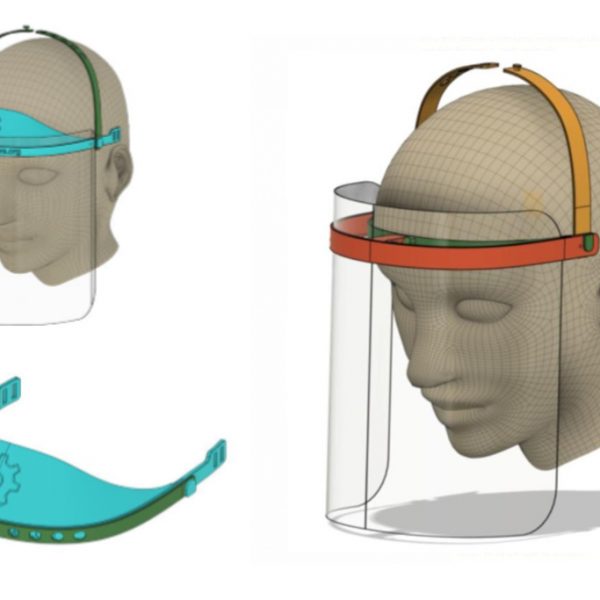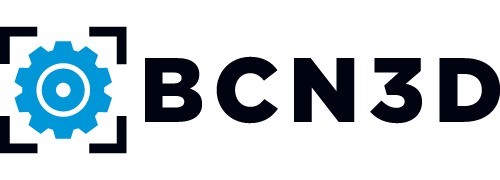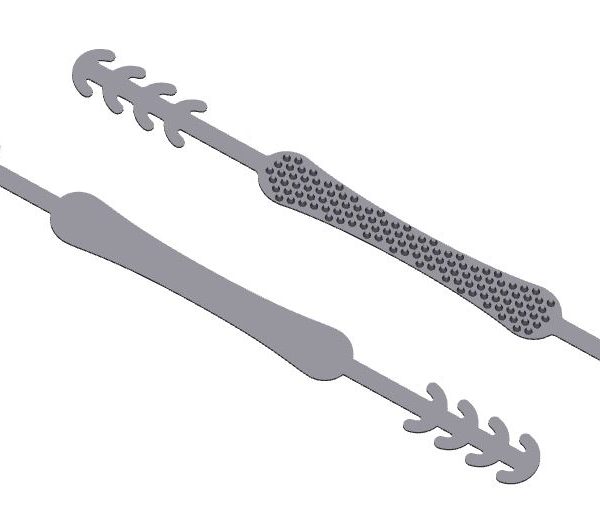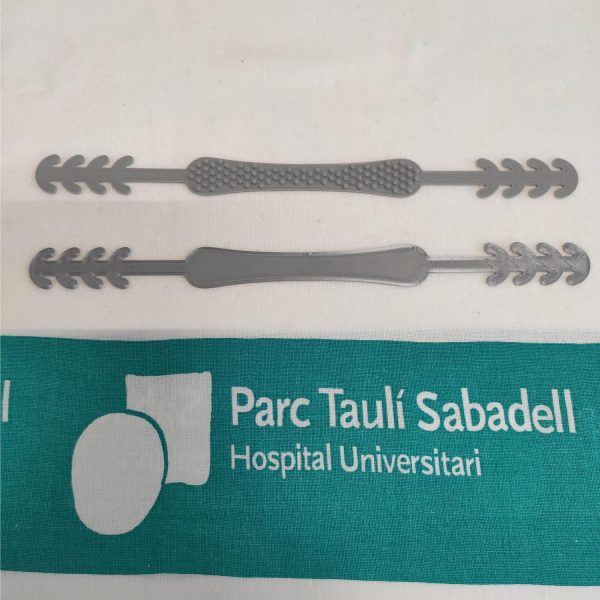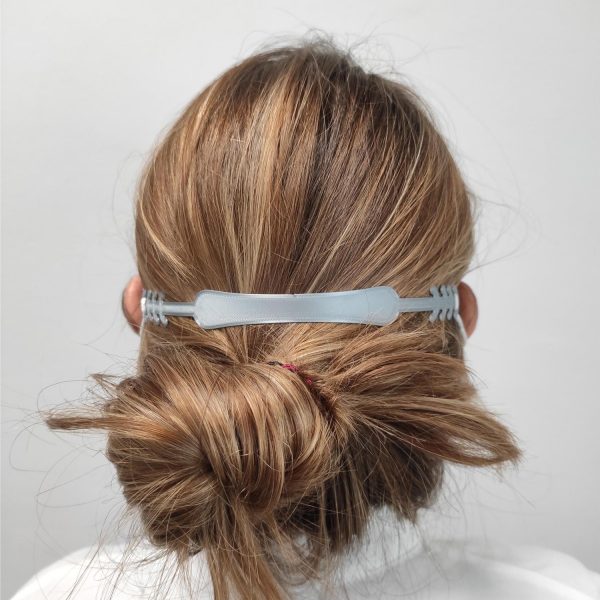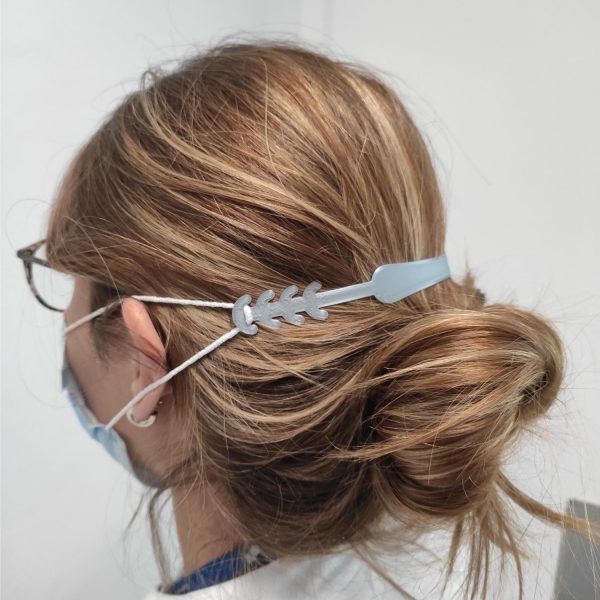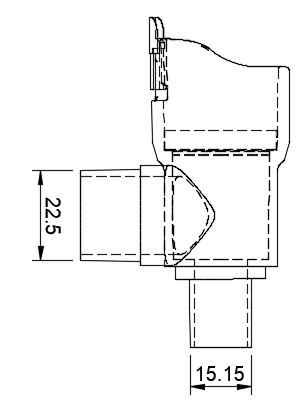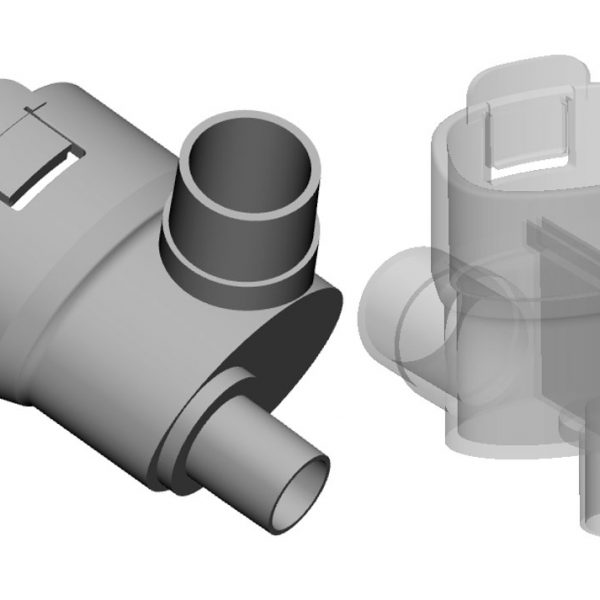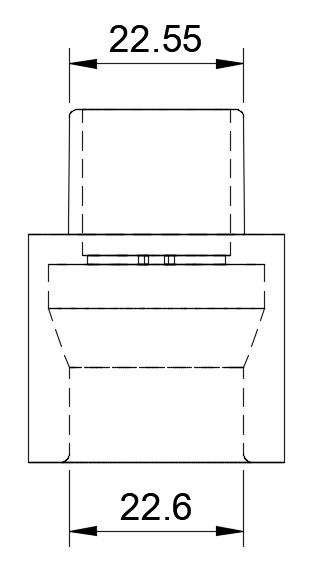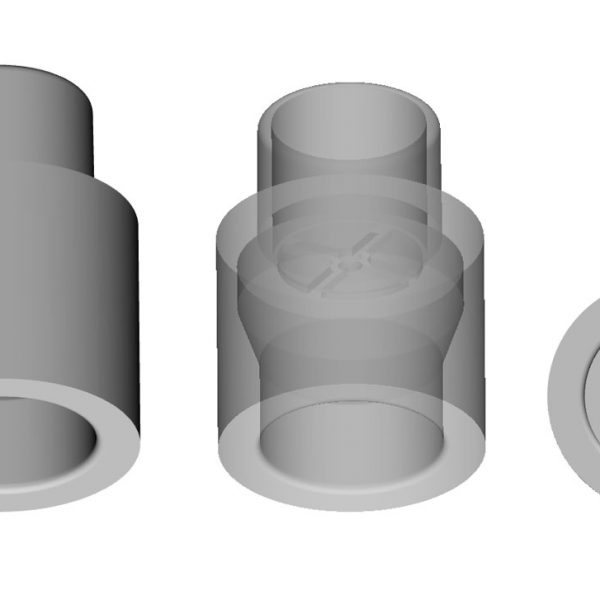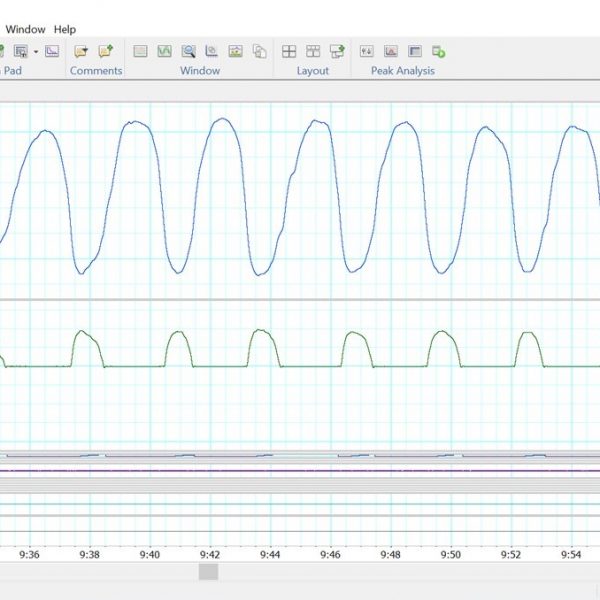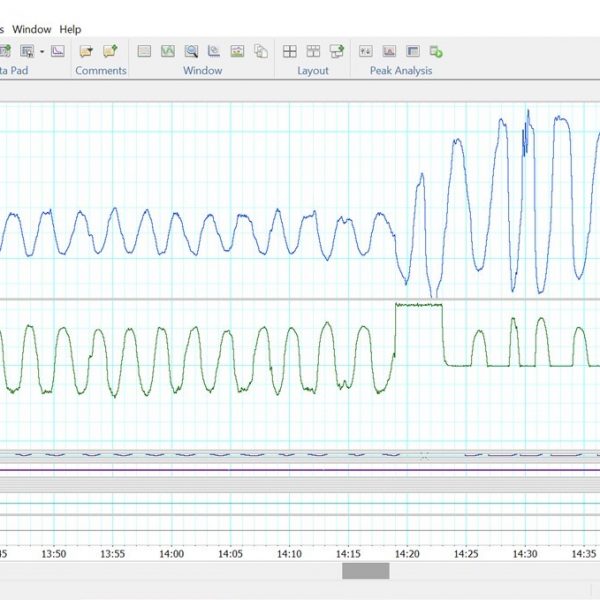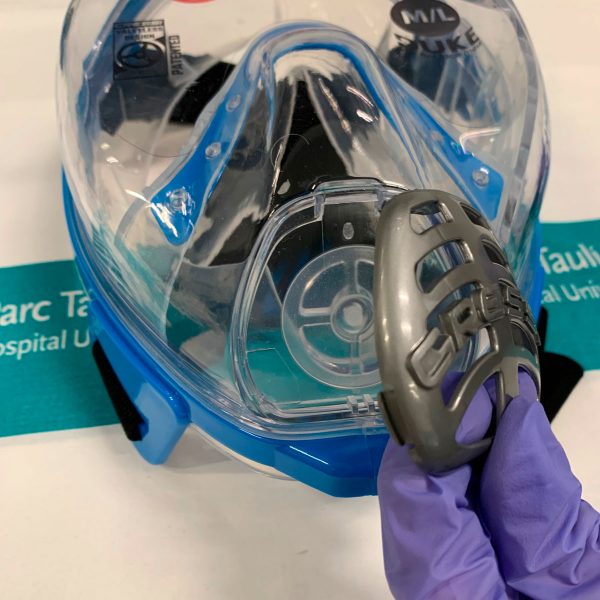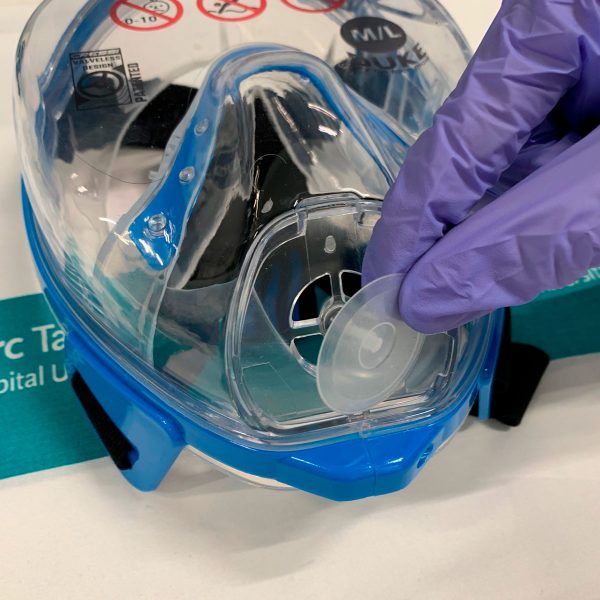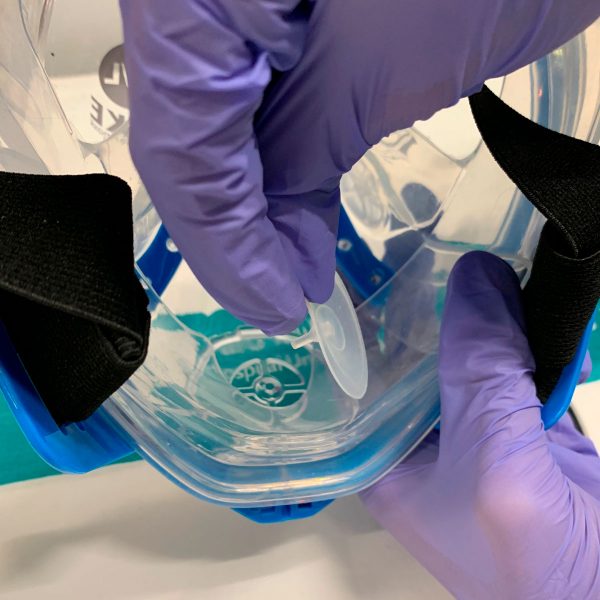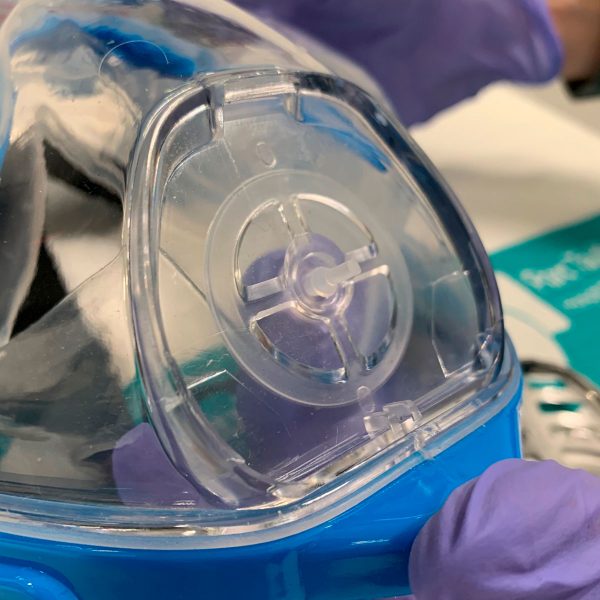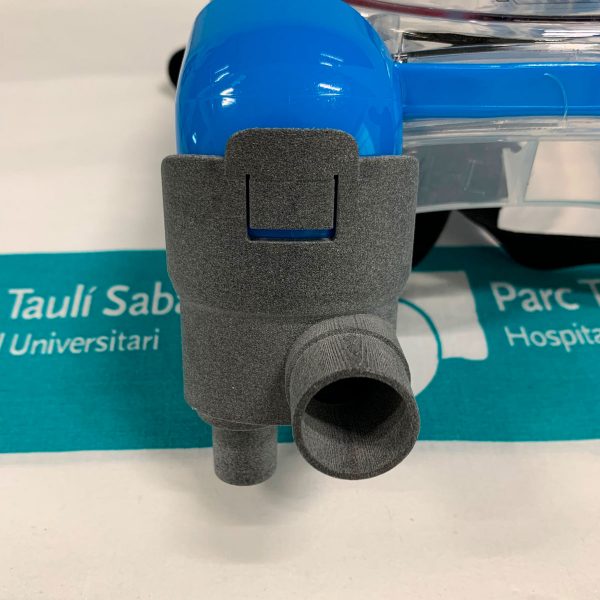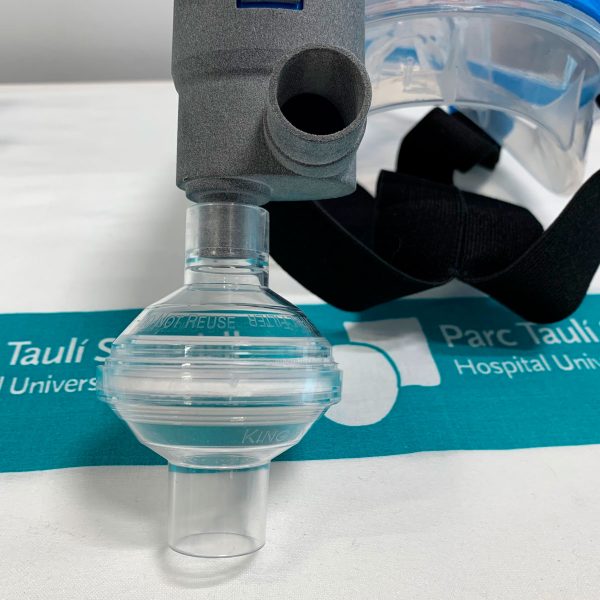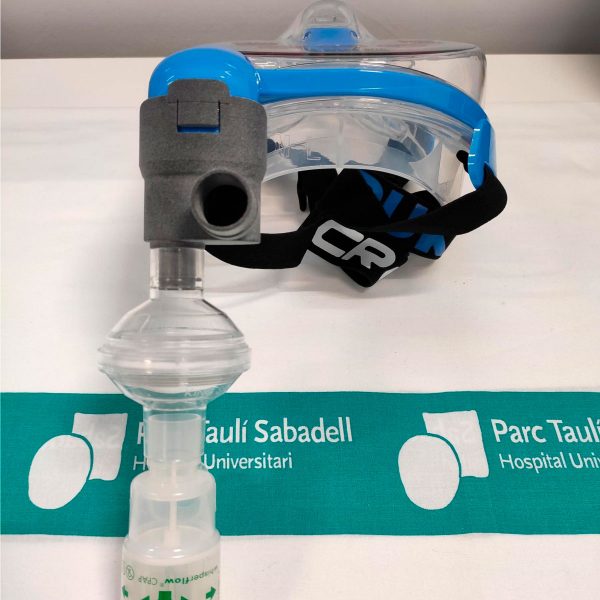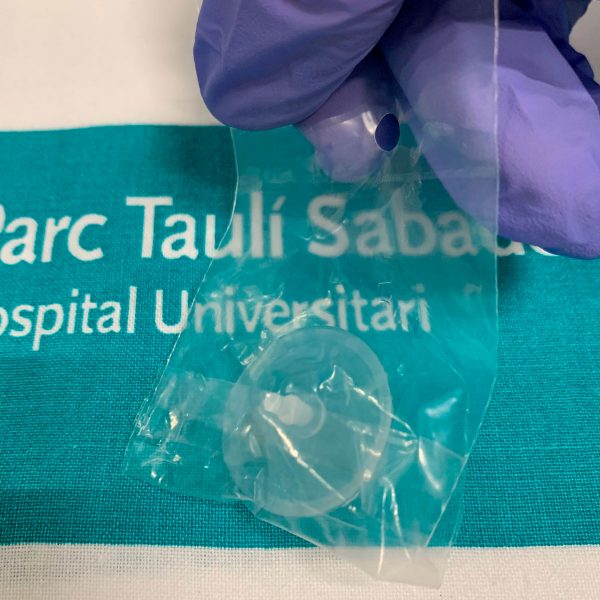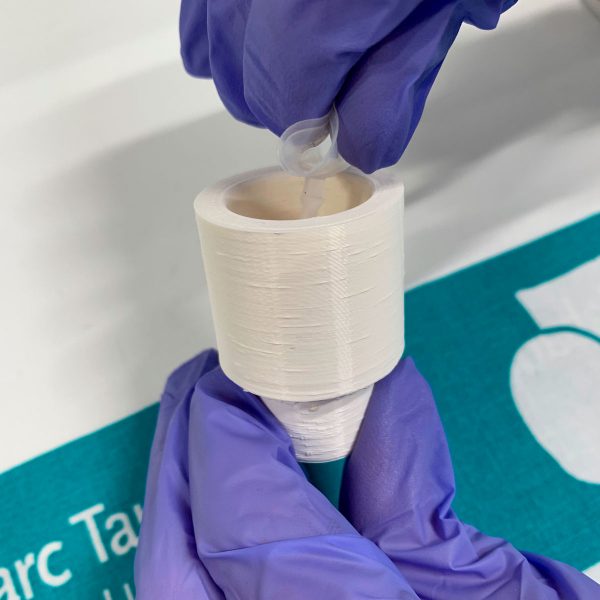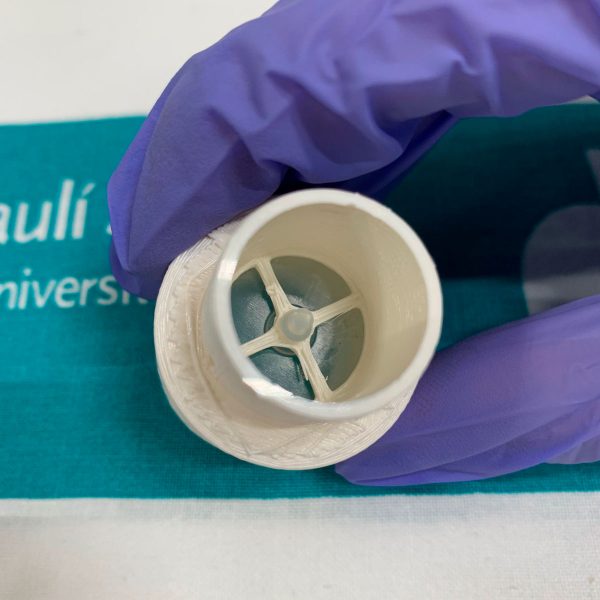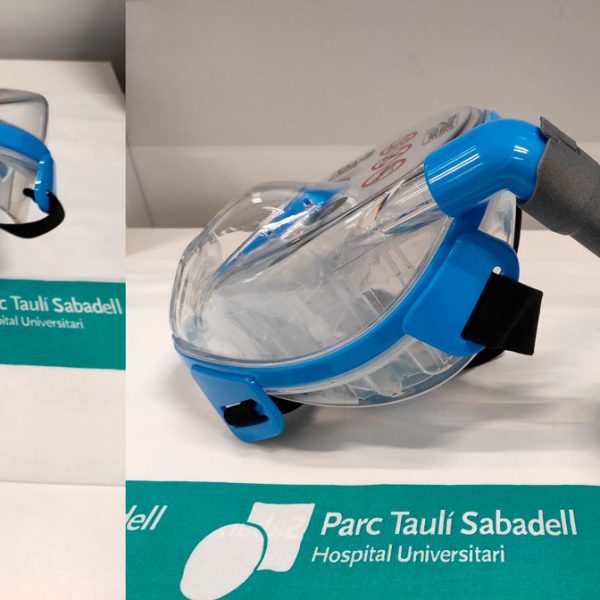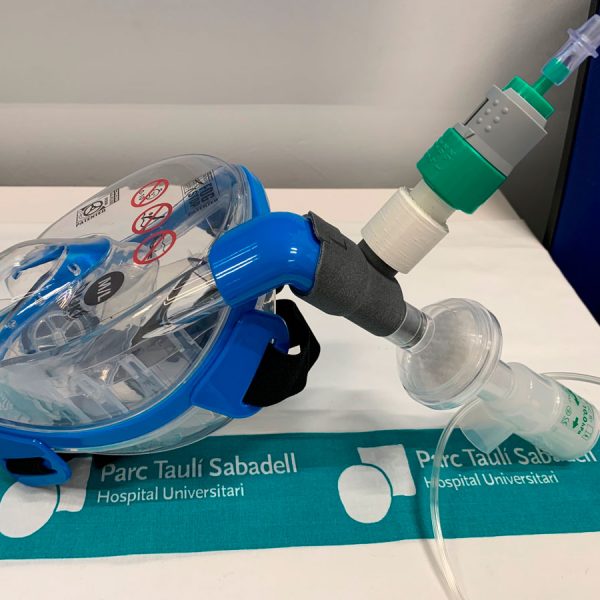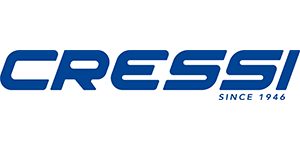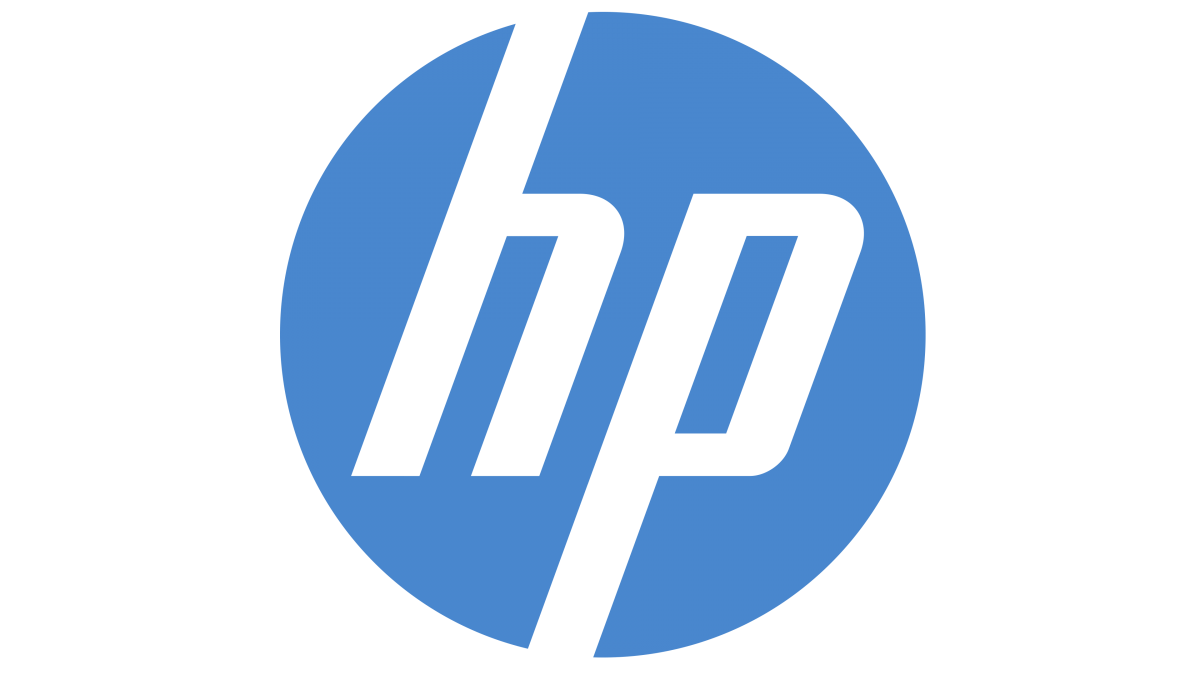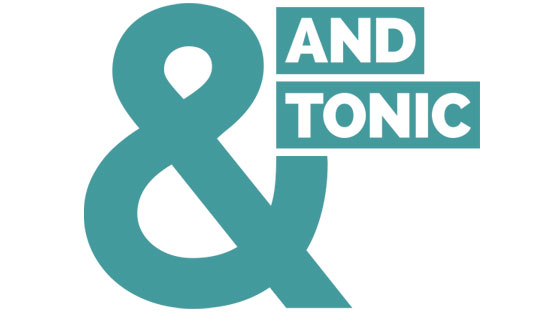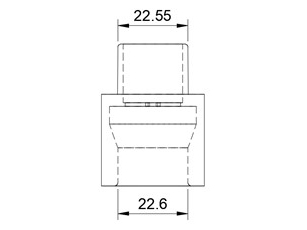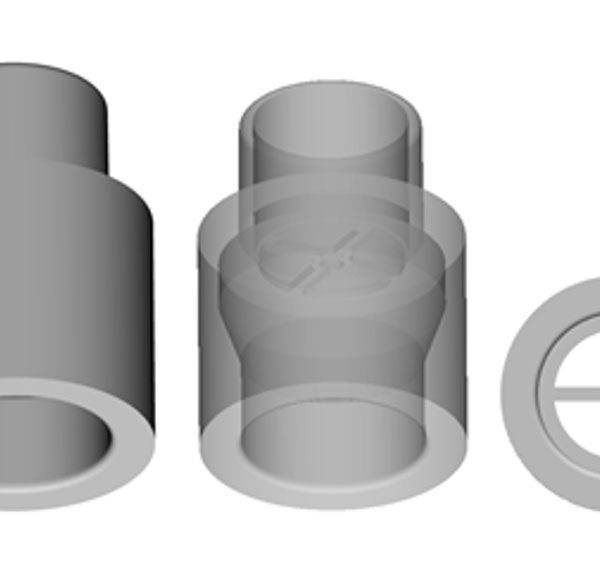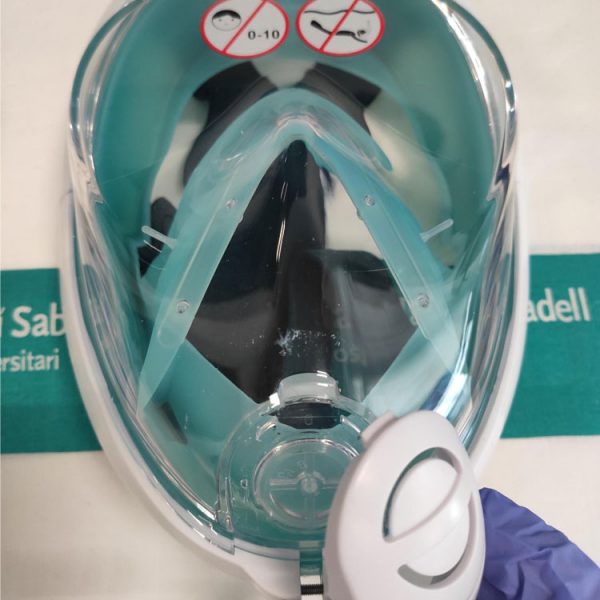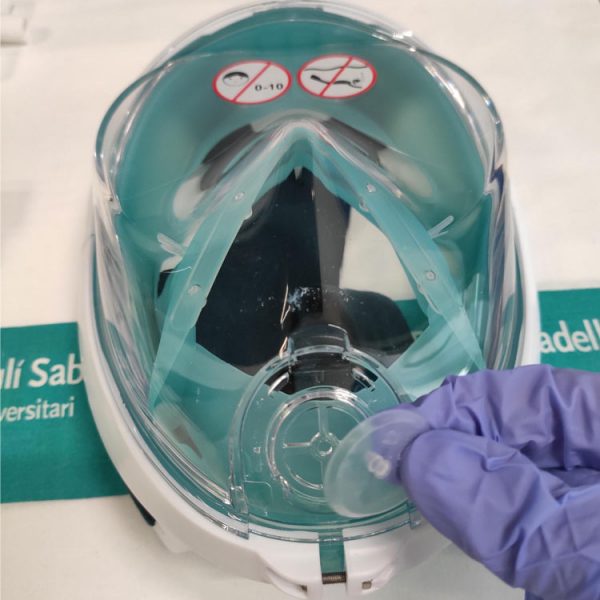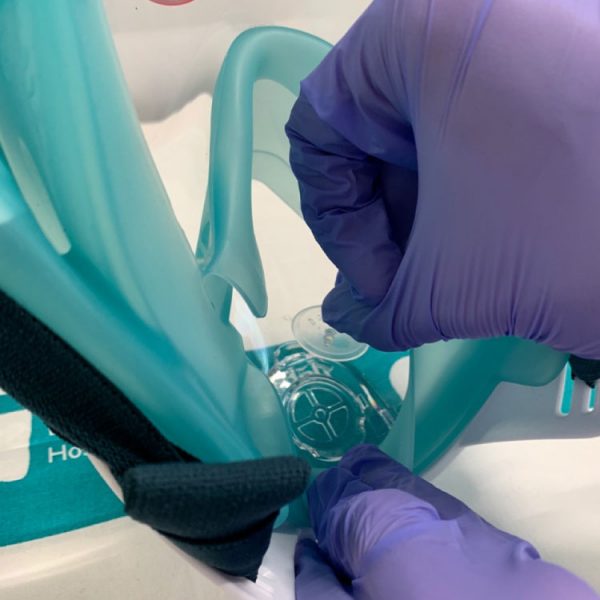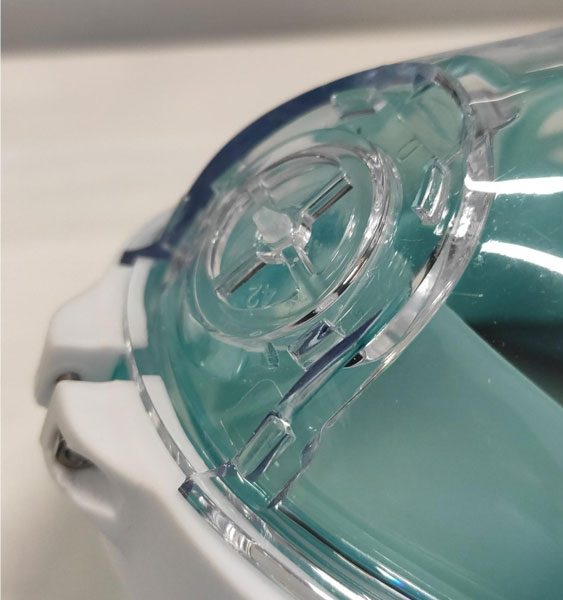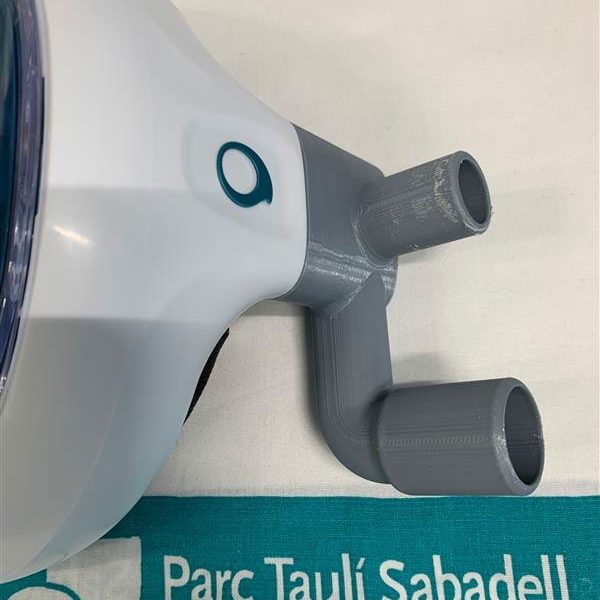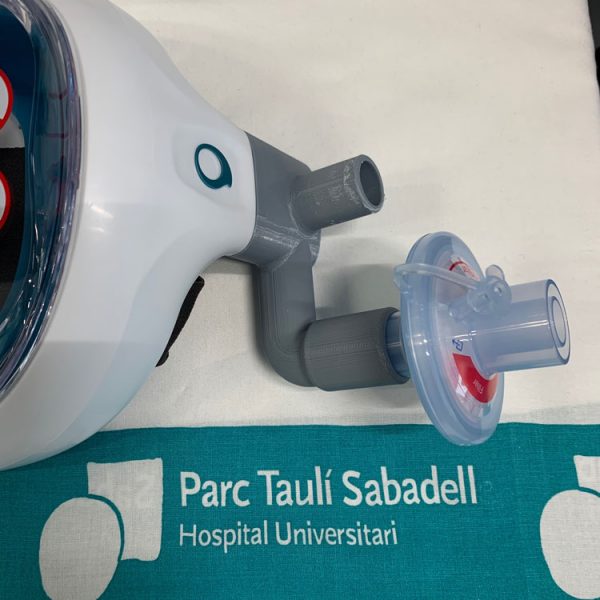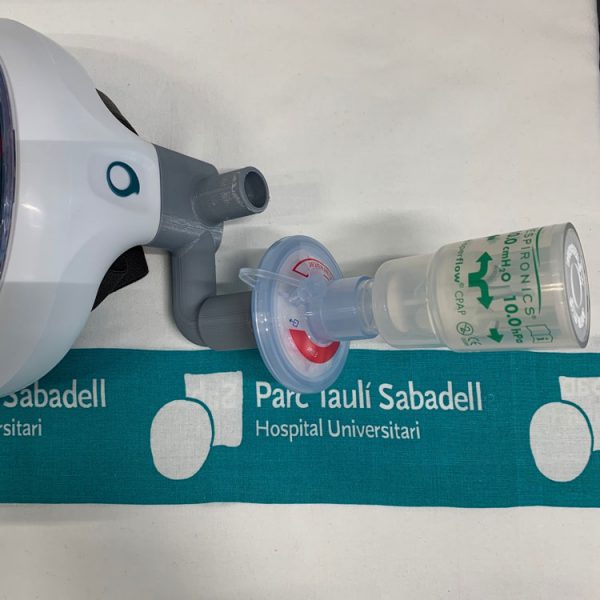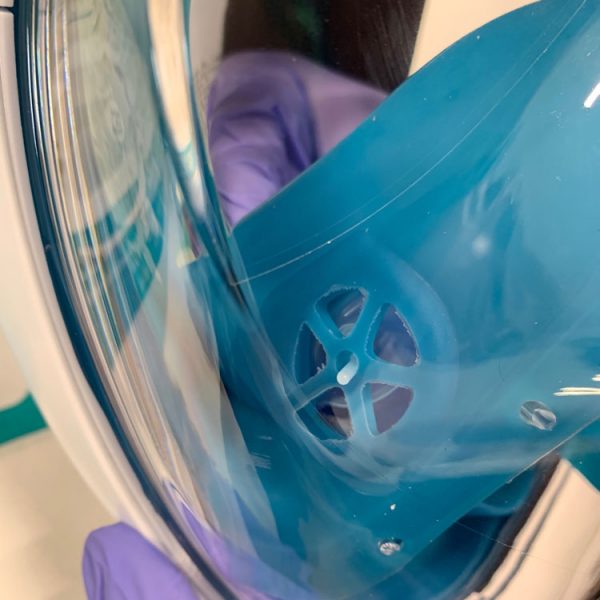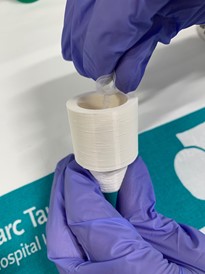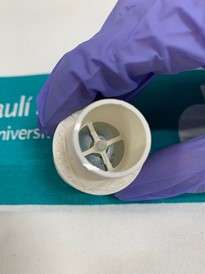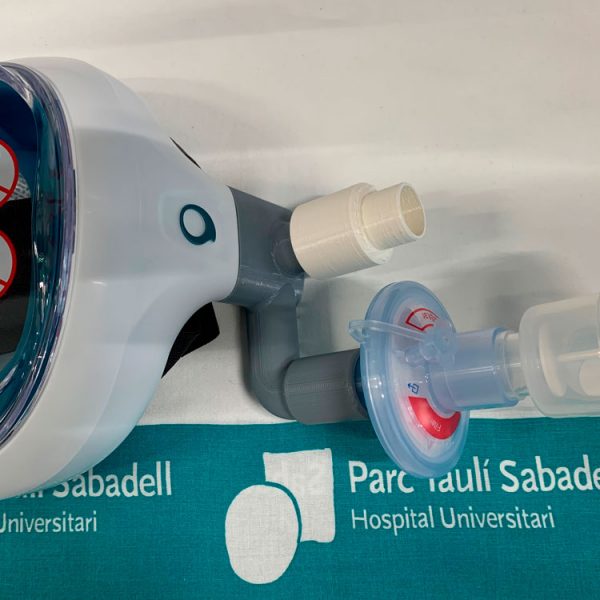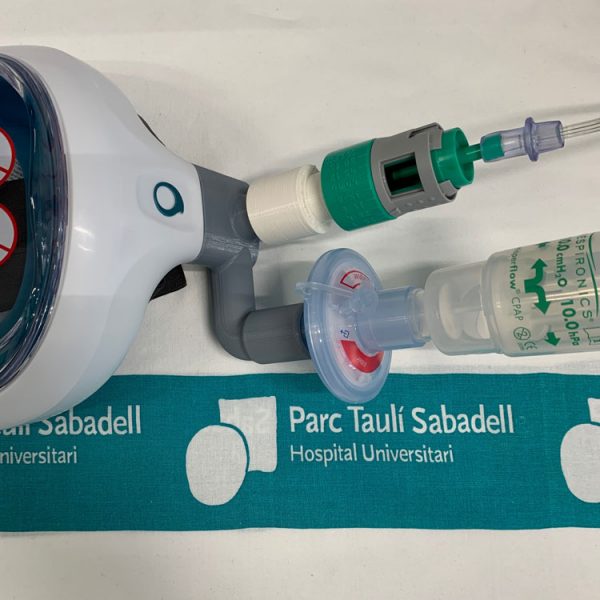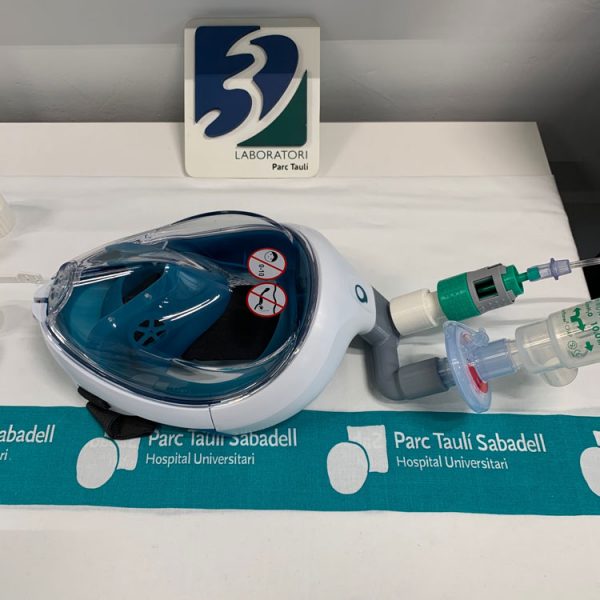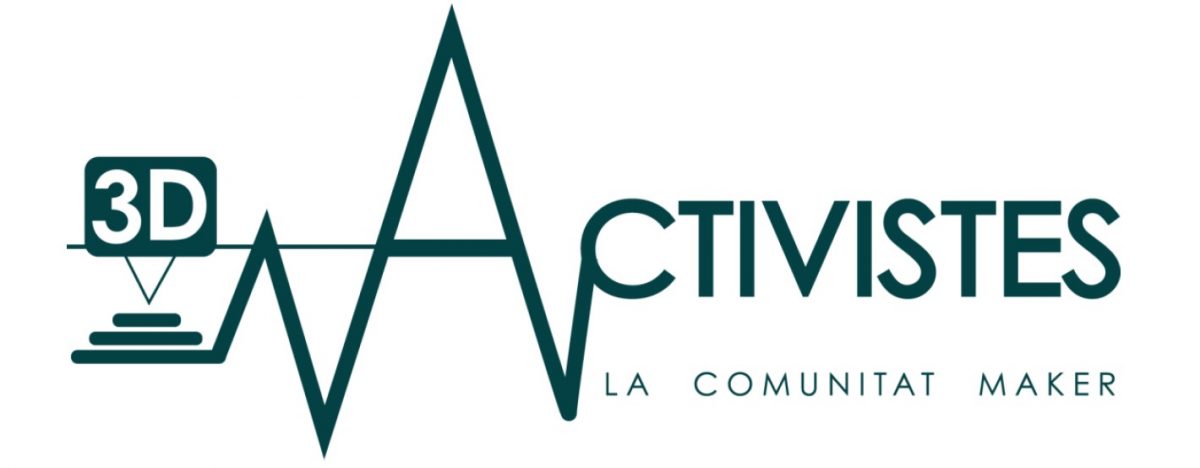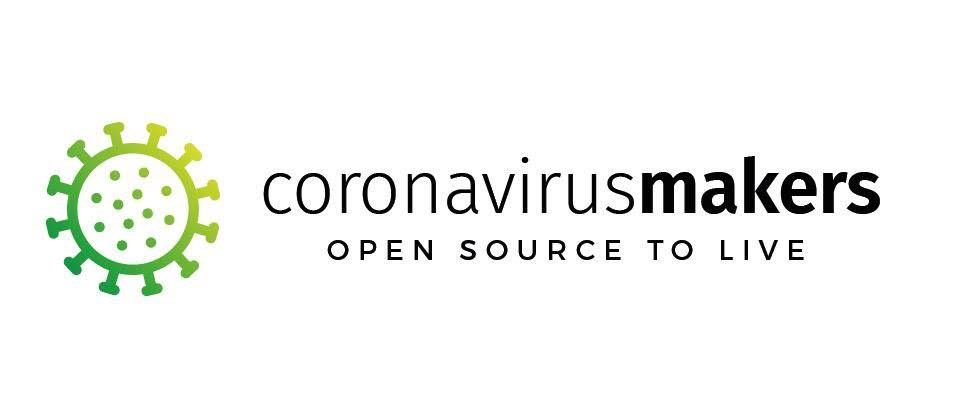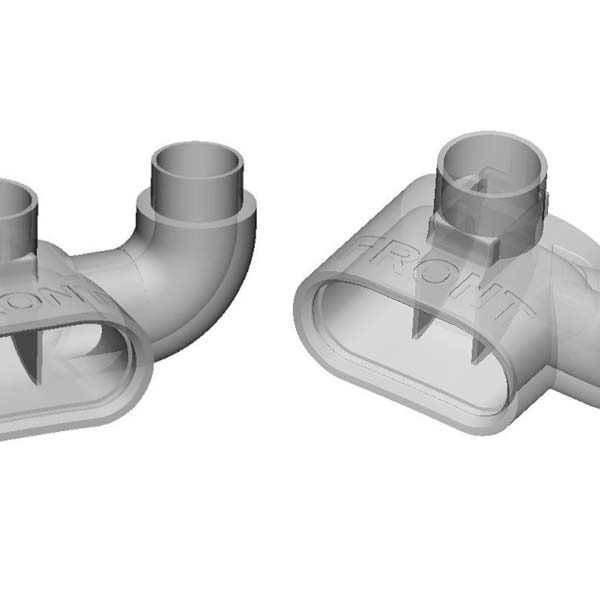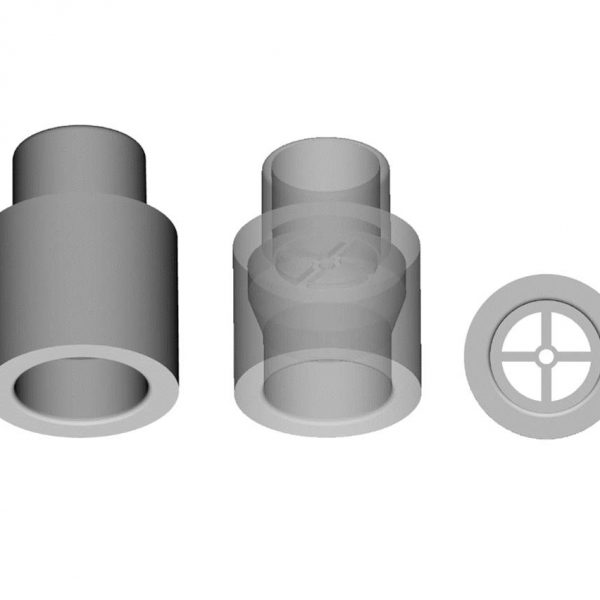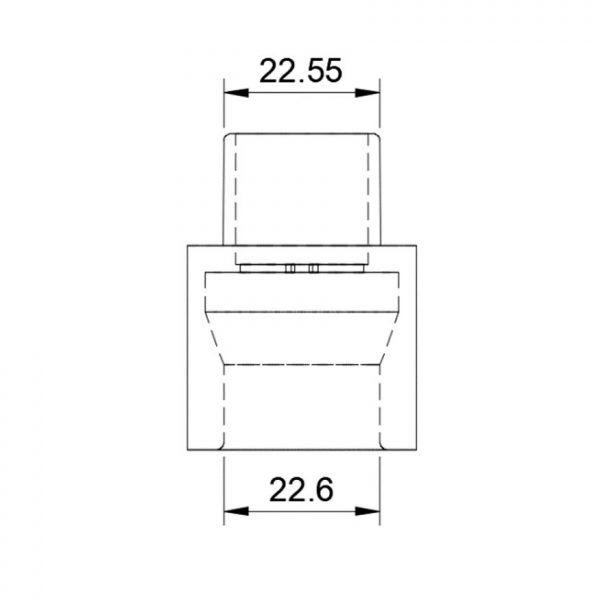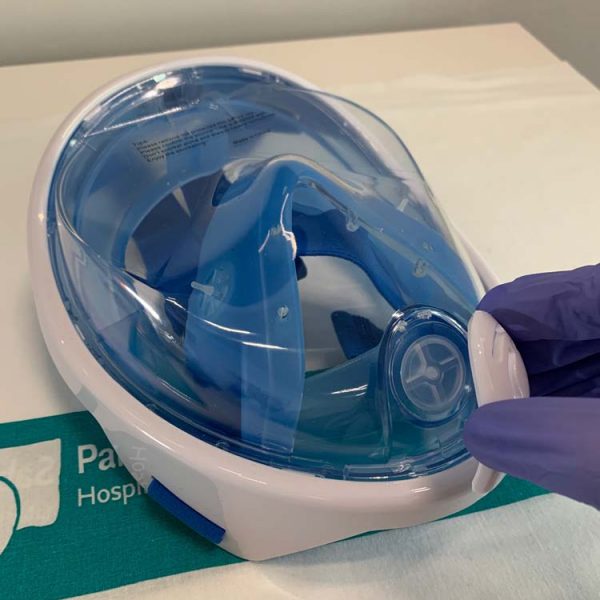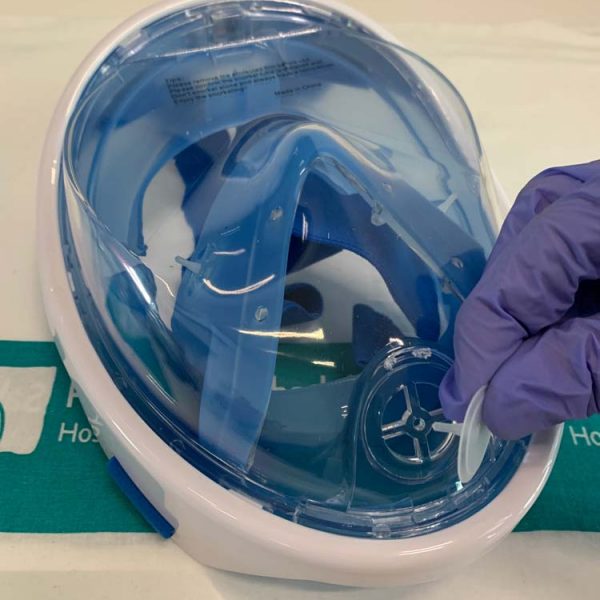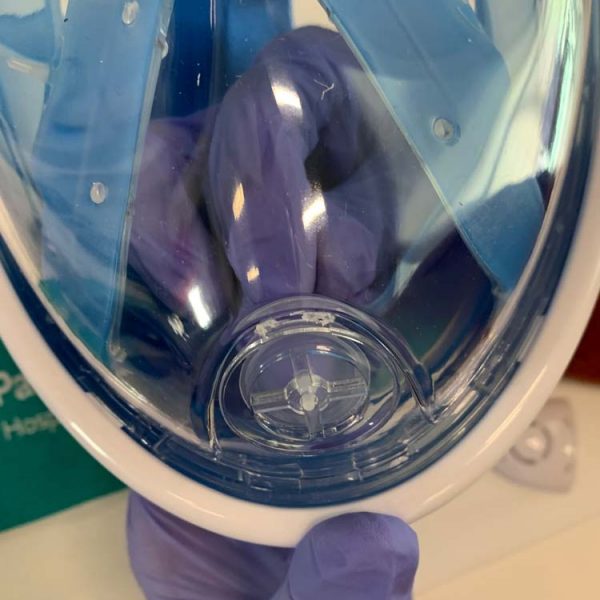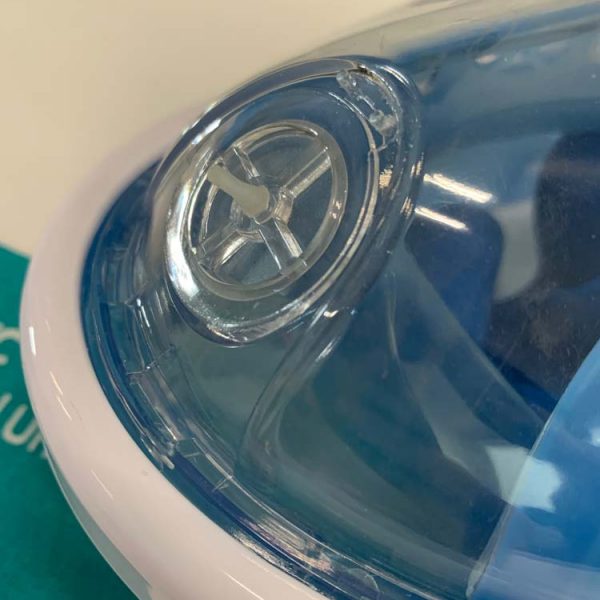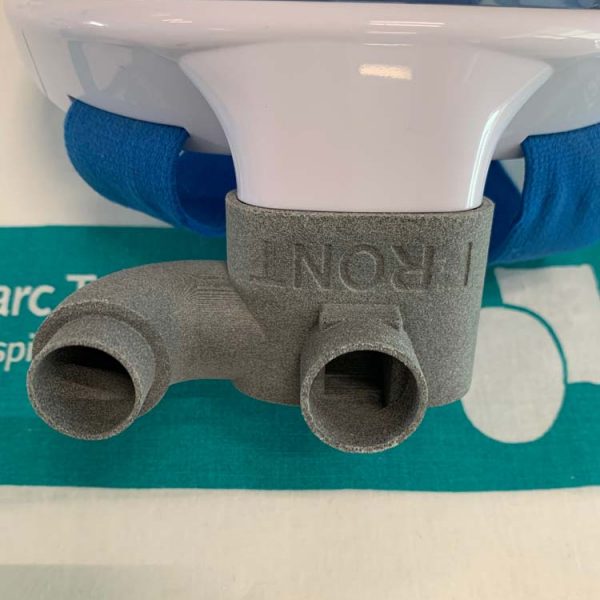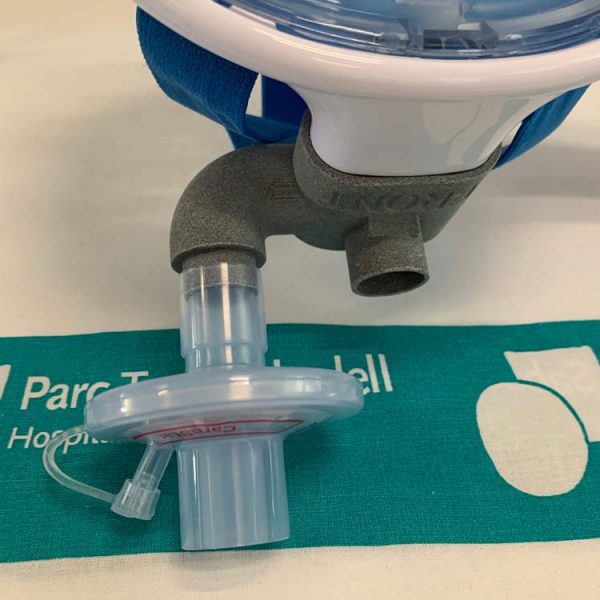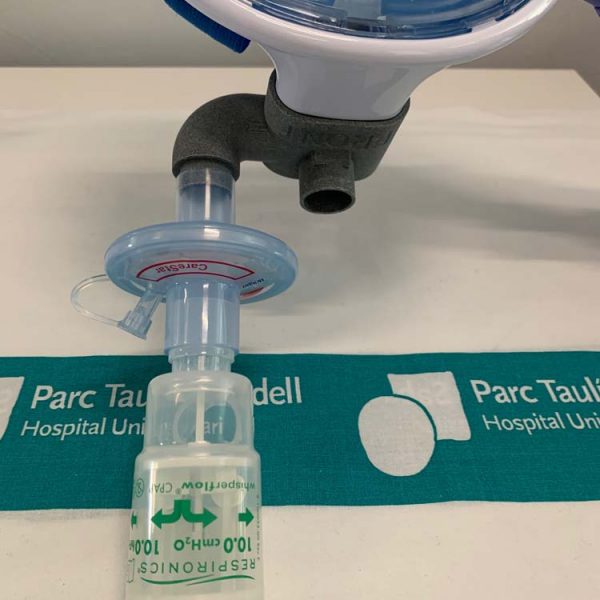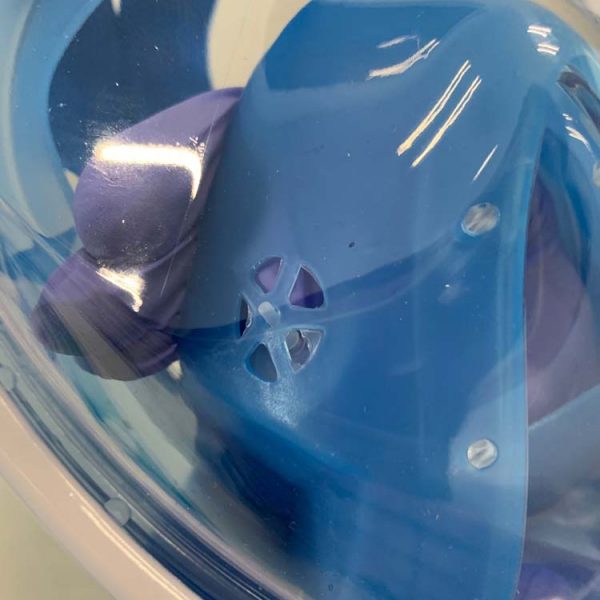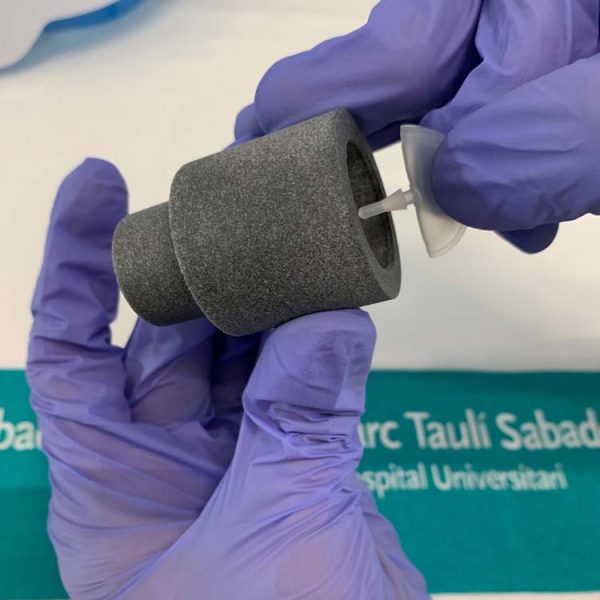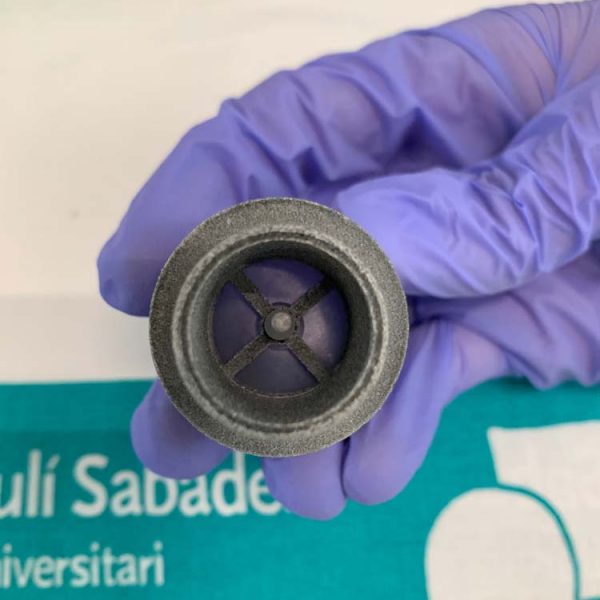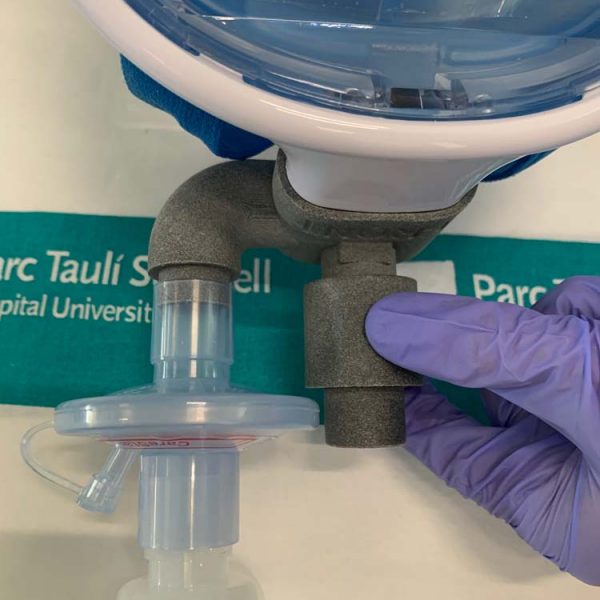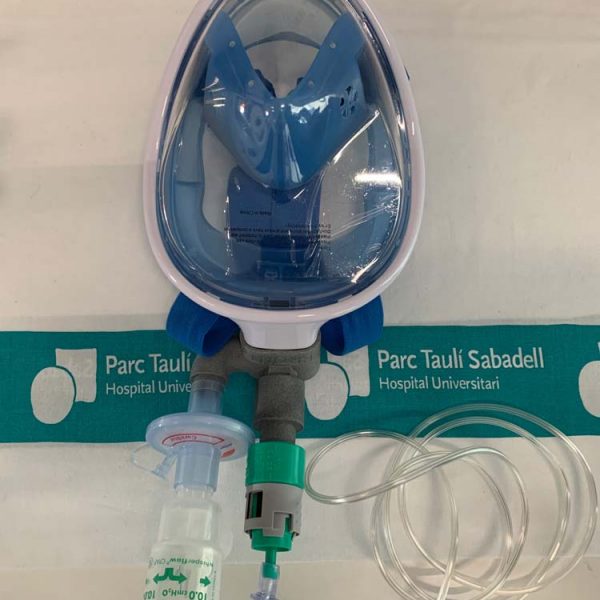Catalog of parts
Select a category. Of the pieces that will come out, this symbol ![]() indicates that it is suitable for makers.
indicates that it is suitable for makers.
- Spare parts and connections by air
- Protection and prevention systems
- Non-invasive ventilation
REFERENCE: 3DPT001
NEED: The need is expected in all hospitals for connecting elbows (orotracheal filter tube) for standard ICU respirator, due to the high foresight of patients who will require intubation at the peak of the epidemic.
VALIDATION: The clinical utility of this piece has been validated in Parc Taulí with PLA by FDM.
PRINTING OPTIONS:
- Material: rigid material (polyamide, PLA, ABS medical, etc).
- Technology: FDM or SLS (a filter must be placed after the piece to prevent dust from entering the patient).
The design and manufacture of this product would not have been possible without the participation and delivery of AsorCAD and Avinent.
REFERENCE: 3DPT005
NEED: Stock outage of standard connection. The need is expected to increase in all hospitals, due to the high foresight of patients who will require intubation at the peak of the epidemic.
VALIDATION: The clinical utility of this piece has been validated in Parc Taulí with PLA by FDM.
PRINTING OPTIONS:
- Material: rigid material (polyamide, PLA, ABS medical, etc).
- Technology: FDM or SLS (a filter must be placed after the piece to prevent dust from entering the patient).
The design and manufacture of this product would not have been possible without the participation and delivery of AsorCAD.
REFERENCE: 3DPT006
NEED: Stock outage of standard connection. The need is expected to increase in all hospitals, due to the high foresight of patients who will require intubation at the peak of the epidemic.
VALIDATION: The clinical utility of this piece has been validated in the Parc Taulí with TPU95A and FDM technology. Other flexible material options are being studied. In principle, SLS technology is excluded due to the risk of dust entering the patient without a rear filter (impossible in this case).
We release three designs:
- V1: No atrial adhesion. Only with elastic rubber fastening through the slots provided in the design.
- V2: With atrial grip. It may not adapt to the patient's condition. In this case we recommend cutting off the earpiece and using the slots provided in the design for use with elastic band.
- V3: Optimized printing. Ideal for optimized production. We have eliminated and shortened the design. It is necessary to secure it with rubber system.
The design and manufacture of this product would not have been possible without the participation and delivery of AsorCAD and Nexeo Plastics.
REFERENCE: 3DPT007
NEED: Stock outage of standard connection. The need is expected to increase in all hospitals, due to the high foresight of patients who will require intubation at the peak of the epidemic.
VALIDATION: The clinical utility of this piece has been validated in Parc Taulí with PLA by FDM.
PRINTING OPTIONS:
- Material: rigid material (polyamide, PLA, ABS medical, etc).
- Technology: FDM or SLS (a filter must be placed after the piece to prevent dust from entering the patient).
The design and manufacture of this product would not have been possible without the participation and delivery of AsorCAD.
REFERENCE: 3DPT008
NEED: Stock outage of standard connection. The need is expected to increase in all hospitals, due to the high foresight of patients who will require intubation at the peak of the epidemic.
VALIDATION: The clinical utility of this piece has been validated in Parc Taulí with PLA by FDM.
PRINTING OPTIONS:
- Material: rigid material (polyamide, PLA, ABS medical, etc).
- Technology: FDM or SLS (a filter must be placed after the piece to prevent dust from entering the patient).
The design and manufacture of this product would not have been possible without the participation and delivery of AsorCAD.
REFERENCE: 3DPT009
NEED: Stock outage of standard connection. The need is expected to increase in all hospitals, due to the high foresight of patients who will require intubation at the peak of the epidemic.
VALIDATION: The clinical utility of this piece has been validated in Parc Taulí with PLA by FDM.
PRINTING OPTIONS:
- Material: rigid material (polyamide, PLA, ABS medical, etc).
- Technology: FDM or SLS (a filter must be placed after the piece to prevent dust from entering the patient).
The design and manufacture of this product would not have been possible without the participation and delivery of AsorCAD.
REFERENCE: 3DPT010
NEED: Stock outage of standard connection. The need is expected to increase in all hospitals, due to the high foresight of patients who will require intubation at the peak of the epidemic.
VALIDATION: The clinical utility of this piece has been validated in Parc Taulí with PLA by FDM.
PRINTING OPTIONS:
- Material: rigid material (polyamide, PLA, ABS medical, etc).
- Technology: FDM or SLS (a filter must be placed after the piece to prevent dust from entering the patient).
REFERENCE: 3DPT011
NEED: Stock outage of standard connection. The need is expected to increase in all hospitals, due to the high foresight of patients who will require intubation at the peak of the epidemic.
VALIDATION: The clinical utility of this piece has been validated in Parc Taulí with PLA by FDM.
PRINTING OPTIONS:
- Material: rigid material (polyamide, PLA, ABS medical, etc).
- Technology: FDM or SLS (a filter must be placed after the piece to prevent dust from entering the patient).
Dr. Manel Lujan, Pulmonologist at Parc Taulí, explains in the following video the clinical usefulness of this piece. Specifically, it is an improvement over standard parts as it has a size that allows more air flow to enter and patients have been detected to improve more quickly.
REFERENCE: 3DPT012
NEED: Stock outage of standard connection. The need is expected to increase in all hospitals, due to the high foresight of patients who will require intubation at the peak of the epidemic.
VALIDATION: The clinical utility of this piece has been validated in Parc Taulí with PLA by FDM.
PRINTING OPTIONS:
- Material: rigid material (polyamide, PLA, ABS medical, etc).
- Technology: FDM or SLS (a filter must be placed after the piece to prevent dust from entering the patient).
REFERENCE: 3DPT013
NEED: Stock outage of standard connection. The need is expected to increase in all hospitals, due to the high foresight of patients who will require intubation at the peak of the epidemic.
VALIDATION: The clinical utility of this piece has been validated in Parc Taulí with PLA by FDM.
PRINTING OPTIONS:
- Material: rigid material (polyamide, PLA, ABS medical, etc).
- Technology: FDM or SLS (a filter must be placed after the piece to prevent dust from entering the patient).
The design and manufacture of this product would not have been possible without the participation and delivery of AsorCAD.
REFERENCE: 3DPT014
NEED: Stock outage of standard connection. The need is expected to increase in all hospitals, due to the high foresight of patients who will require intubation at the peak of the epidemic.
VALIDATION: The clinical utility of this piece has been validated in Parc Taulí with PLA by FDM.
PRINTING OPTIONS:
- Material: rigid material (polyamide, PLA, ABS medical, etc).
- Technology: FDM or SLS (a filter must be placed after the piece to prevent dust from entering the patient).
The design and manufacture of this product would not have been possible without the participation and delivery of AsorCAD.
REFERENCE: 3DPT015
NEED: Stock outage of standard connection. The need is expected to increase in all hospitals, due to the high foresight of patients who will require intubation at the peak of the epidemic.
VALIDATION: The clinical utility of this piece has been validated in Parc Taulí with PLA by FDM.
PRINTING OPTIONS:
- Material: rigid material (polyamide, PLA, ABS medical, etc).
- Technology: FDM or SLA with dental resins.
ASSEMBLY INSTRUCTIONS:
The design and manufacture of this product would not have been possible without the participation and delivery of AsorCAD.
REFERENCE: 3DPT016
NEED: Stock outage of standard connection. The need is expected to increase in all hospitals, due to the high foresight of patients who will require intubation at the peak of the epidemic.
VALIDATION: The clinical utility of this piece has been validated in Parc Taulí with PLA by FDM.
PRINTING OPTIONS:
- Material: rigid material (polyamide, PLA, ABS medical, etc).
- Technology: FDM or SLS (a filter must be placed after the piece to prevent dust from entering the patient).
The design and manufacture of this product would not have been possible without the participation and delivery of AsorCAD.
REFERENCE: 3DPT018
NEED: Stock outage of standard connection. The need is expected to increase in all hospitals, due to the high foresight of patients who will require intubation at the peak of the epidemic.
VALIDATION: The clinical utility of this piece has been validated in Parc Taulí with PLA by FDM.
PRINTING OPTIONS:
- Material: rigid material (polyamide, PLA, ABS medical, etc).
- Technology: FDM or SLS (a filter must be placed after the piece to prevent dust from entering the patient).
The design and manufacture of this product would not have been possible without the participation and delivery of AsorCAD.
REFERENCE: 3DPT019
NEED: Stock outage of standard connection. The need is expected to increase in all hospitals, due to the high foresight of patients who will require intubation at the peak of the epidemic.
CLINICAL VALIDATION:
Leak testing has been performed with pressure and flow monitoring in CPAP mode and distal occlusion at the leak port. The CPAP pressure value was increased from 4 to 16 in incremental intervals of 2 cm H2O and at an acquisition frequency of 200 Hz. It is considered in this situation (occlusion and absence of active patient) that the flow value represents the leakage value for each pressure value analyzed. The data was imported into Microsoft Excel, determining for each piece the pressure / leak equation.
Results:
It was determined that the part manufactured in 3D has a slightly higher level of leakage for each pressure level analyzed with respect to its commercial counterpart. The attached figure reflects the pressure / leakage ratio of each of the pieces analyzed in the laboratory, along with the correlations of each of them.
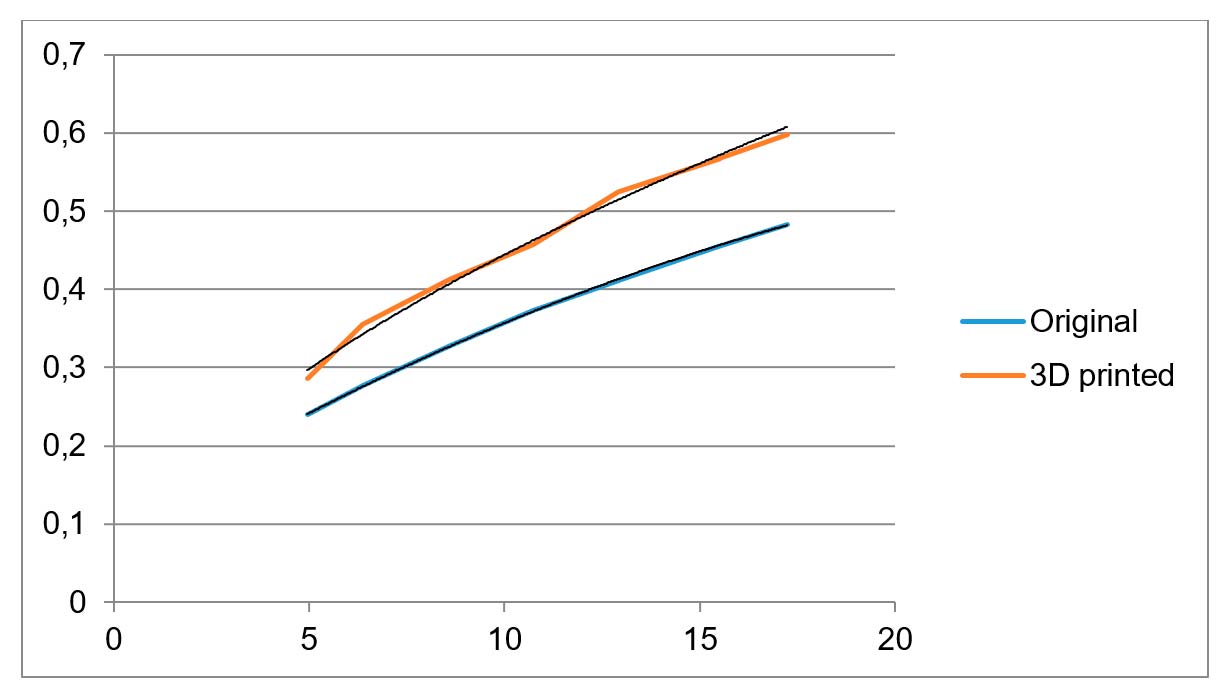
Pressure ratio (horizontal axis) with leaks (vertical axis) for the original piece and the one designed in 3D.
Relational equations:
- Leakage (original) = -0,0005p2 + 0,03p + 0,1035 (R² = 0,9998)
- Leakage (3D) = -0,0008p2 + 0,0434p + 0,1005 (R² = 0,9948)
In conclusion, the 3D-printed piece has a slightly higher leakage level than the original, which can even prevent re-inhalation at high current volumes.
PRINT VALIDATION: The clinical utility of this piece has been validated in Parc Taulí with PLA by FDM.
PRINTING OPTIONS:
- Material: rigid material (polyamide, PLA, ABS medical, etc).
- Technology: FDM or SLS (a filter must be placed after the piece to prevent dust from entering the patient).
The design and manufacture of this product would not have been possible without the participation and delivery of AsorCAD.
PART 1 (3DPT022-1)
PART 2 (3DPT022-2)
PART 3 (3DPT022-3)
REFERENCE: 3DPT022
NEED: Standard valve stock outage. The need is expected to increase in all hospitals, due to the high forecast of patients who will require assisted ventilation at the peak of the epidemic.
CHARACTERISTICS OF THE SPRINGS:
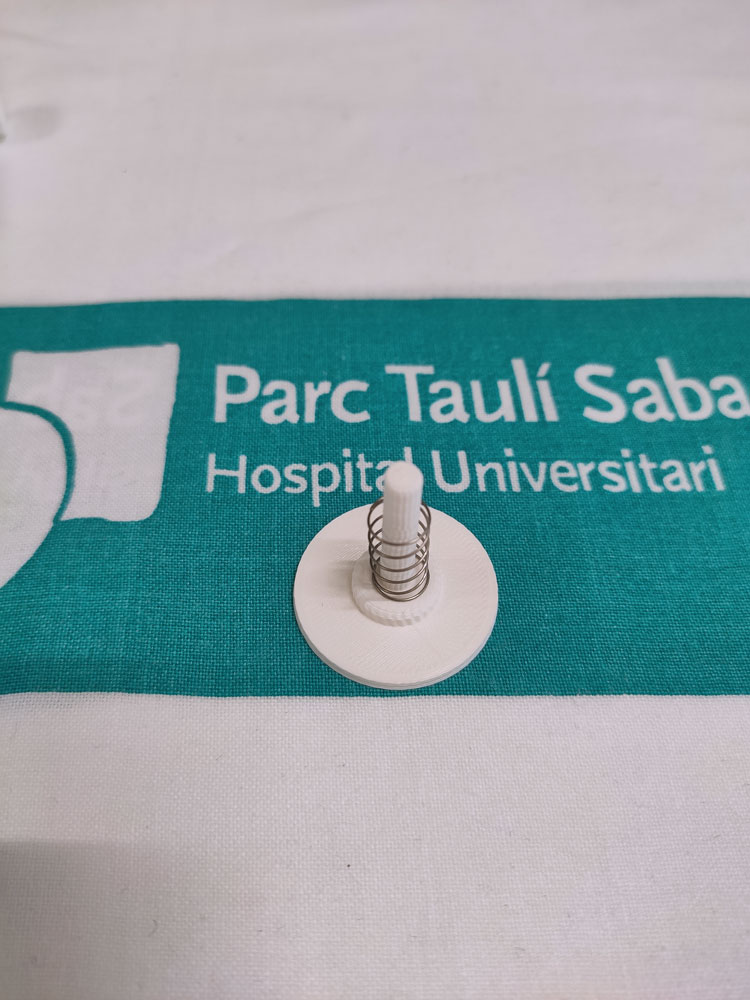
Inner spring:
- Wire diameter: 0.42 mm
- Circle diameter: 7.2 mm
- Length: 16 mm
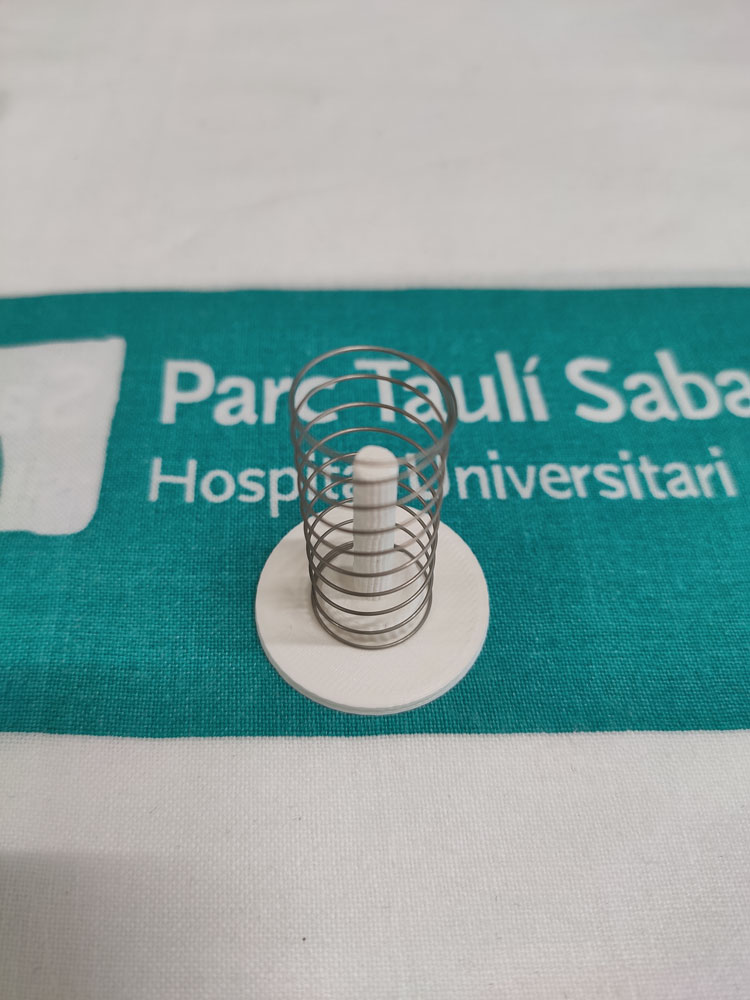
Outer spring:
- Wire diameter: 0.44 mm
- Circle diameter: 14 mm
- Length: 35 mm
SYSTEM CALIBRATION:
For the calibration of the PEEP valves an in-silico study has been carried out using CPAP system configured with 10 cm H2O IPAP with 6 3DPT022 coupled units with springs A and B (described above). The material used for printing has been PLA with FDM technology.
Subsequent to the calibration the mark of 10cm of H2O has been added in the design in addition to a security system by means of thread stop that limits the pressure to a maximum of 12 cm of H2O.
VALIDATION: The clinical utility of this piece has been validated in Parc Taulí with PLA by FDM.
PRINTING OPTIONS:
- Material: rigid material (polyamide, PLA, ABS medical, etc).
- Technology: FDM, SLA or SLS.
The design and manufacture of this product would not have been possible without the participation and delivery of AsorCAD and Muelles Santasusana.
WARNING: Use of this product is not authorized by AEMPS. Its use is the responsibility of the end user. Each hospital must request the appropriate authorization for use in patients.
REFERENCE: 3DPT024
NEED: Stock outage of standard connection. The need is expected to increase in all hospitals, due to the high foresight of patients who will require intubation at the peak of the epidemic.
VALIDATION: The clinical utility of this piece has been validated in the Parc Taulí by FDM SLA biocompatible for Class I health product.
PRINTING OPTIONS:
- Material: rigid material (polyamide, PLA, ABS medical, etc).
- Technology: FDM or SLA. SLS is discarded for possible pulse entry into the patient.
The design and manufacture of this product would not have been possible without the participation and delivery of AsorCAD.
REFERENCE: 3DPT025
NEED: Stock outage of standard connection. The need is expected to increase in all hospitals, due to the high foresight of patients who will require intubation at the peak of the epidemic.
VALIDATION: The clinical utility of this piece has been validated in the Parc Taulí with TPU95A and FDM technology. Other flexible material options are being studied.
REFERENCE: 3DPT026_VH
NEED: Stock outage of standard connection. The need is expected to increase in all hospitals, due to the high foresight of patients who will require intubation at the peak of the epidemic.
VALIDATION: The clinical utility of this piece has been validated at Vall d'Hebron Hospital with FDM technology and PLA material.
PRINTING OPTIONS:
- Material: rigid material (polyamide, PLA, ABS medical, etc).
- Technology: FDM, SLS or SLA. For autoclave sterilization SLS technology with Polyamide is recommended for medical use.
The design and manufacture of this product would not have been possible without the participation and delivery of AsorCAD.
REFERENCE: 3DPT027
NEED: Stock outage of standard connection. The need is expected to increase in all hospitals, due to the high foresight of patients who will require intubation at the peak of the epidemic.
VALIDATION: The clinical utility of this piece has been validated in Parc Taulí with PLA by FDM.
PRINTING OPTIONS:
- Material: rigid material (polyamide, PLA, ABS medical, etc).
- Technology: FDM or SLS (a filter must be placed after the piece to prevent dust from entering the patient).
The design and manufacture of this product would not have been possible without the participation and delivery of AsorCAD.
REFERENCE: 3DPT002
NEED: Door handles are one of the most viral and bacterial loads on buildings. The reason is the recurring contact on the part of different users, added to the fact that it is not an element that is cleaned continuously.
VALIDATION: The design of this product has been validated in our hospital and is used for handles with a maximum diameter of 20 mm (no specific minimum, as it rests on the door at the bottom). It is intended for printing in both FDM and SLS. Other options for biocompatible materials and 3D printing technologies are being studied.
This product was designed by Mastertec and validated at Parc Taulí.
REFERENCE: 3DPT020_HSJD
NEED: In the current situation of sanitary emergency, and due to the lack of stock of commercial material, the sanitary personnel that cannot accede to other materials can make a temporary use of this design, always assuring conditions of production and sterilization that ensure their safety.
VALIDATION: The clinical utility of this piece has been validated at the Hospital Sant Joan de Déu in Barcelona. The strength of the material has been validated with Frekaderm ®, a disinfectant antiseptic for medical devices, checking that the piece resists: the screen does not whiten and does not lose transparency.
PRINTING AND COUPLING OPTIONS:
- Support Material: Non-porous material resistant to cleaning with Frekadern ® type disinfectant. Tested with PET-G (Glycol Polyethylene Terephthalate).
- Screen Material: Non-porous material resistant to cleaning with Frekadern ® type disinfectant. PVC (Vinyl Polychloride) or PP (Polypropylene). A4 sheets with rounded tips. It is tested with 200 microns with acceptable result. 500 microns or higher is recommended. Secure sealed with thermos on the top visor.
- Technology: FDM, SLS or SLA. In the case of FDM:
- Printing time: 1h 50
- Material: 37 g
- Print settings:
- Nozzle diameter: 0.4 mm
- Layer height: 0.28 mm
- In-fill: 50% minimum
The design and manufacture of this product would not have been possible without the participation and delivery of BCN3D and CovidMakers.
REFERENCE: 3DPT031
NEED: Prolonged use of protective masks for long periods of time can cause pain, irritation, and dermabrasion on the skin of the ear with healthcare personnel. This solution carries the pressure of the hold behind the head to release the pressure from the ear.
VALIDATION: The clinical utility of this piece has been tested in Parc Taulí with PLA by FDM.
PRINTING OPTIONS:
- Material: PLAN, PA11, PA12.
- Technology: FDM or SLS.
This product has been co-designed by Peak Sport Products Co and HP and has been tested at Parc Taulí thanks to the community of Coronavirus Makers. More information about the product at HP website.
Dr. Manel Luján, a pulmonologist at Parc Taulí, explains the process of clinical validation of the Duke de Cressi mask for use as a CPAP system, as well as the procedure to be followed for its assembly.
PART 1 (3DPT021-1)
Cressi® Duke Mask Adapter
PART 2 (3DPT021-2)
Support for non-return valve
OPTIONAL: PART 3 (3DPT024)
Only in the absence of the availability of a bactericidal filter. See piece “3DPT024 - Straight Connector 15-22mm for airway tube”.
REFERENCE: 3DPT021
NEED: The need is expected to increase in all hospitals, due to the high foresight of patients who will require non-invasive breathing systems at the peak of the epidemic.
CLINICAL VALIDATION:
- Cressi® Duke Mask
- 3DPT021-1
- 3DPT021-2 coupled with the extra silicone non-return valve, provided by the manufacturer in the same sealing package of the mask.
- 10 cm H2O PEEP valve
The system has been validated with the help of external monitoring, using Powerlab 16 SP polygraph (Adinstruments Australia) equipped with S 300 pneumotachograph (dead space, 80 ml) and 1150 pressure transducer. Both sensors were calibrated against 3 L syringe and water column respectively. A 10 cm H2O threshold valve was placed in the expiratory port (Respironics, Murrysville, Pennsylvania). A gas flow of 15 L / min was introduced using a Venturi system, with the side openings corresponding to 45% FiO2.
Results:
- With non-return valve: Pressures were achieved in the circuit at the expiration end of 10 cm H2O. The presence of retrograde flow was not observed in any test.
- Without return valve: The pressures reached at the end of expiration reach 4 cm H2O (6 cm H2O lower than expected). An increase in retrograde flow was also detected, attributable to the absence of the extra non-return valve.
PRINT VALIDATION: The clinical utility of this piece has been validated in the Parc Taulí by biocompatible FDM for Class I health product.
ASSEMBLY INSTRUCTIONS:
AndTonic has created this video-tutorial to follow step by step the assembly of the mask with the pieces. Also, you can Download the manual in pdf version. Also below is the step-by-step of image montage.
The design and manufacture of this product would not have been possible without the participation and delivery of AsorCAD, Cressi and HP. We also thank AndTonic for its empowerment and dissemination of the initiative.
PART 1 (3DPT023-1)
Decathlon® Subea Easybreath Mask Adapter
PART 2 (3DPT023-2)
Support for non-return valve
OPTIONAL: PART 3 (3DPT024)
Only in the absence of the availability of a bactericidal filter. See piece “3DPT024 - Straight Connector 15-22mm for airway tube”.
REFERENCE: 3DPT023
NEED: The need is expected to increase in all hospitals, due to the high foresight of patients who will require non-invasive breathing systems at the peak of the epidemic.
CLINICAL VALIDATION:
- Decathlon® Subea Easybreath Mask
- 3DPT023-1
- 3DPT023-2 coupled with a silicone return valve obtained in the following ways:
- Test 1: extracted from another mask of the same brand
- Test 2: Extracted from the inner membrane of the mask itself
- Test 3: No return valve
Important: the manufacturer of this brand does not supply any extra valve in the original packaging.
The system has been validated with the help of external monitoring, using Powerlab 16 SP polygraph (Adinstruments Australia) equipped with pneumatachograph S 300 (dead space, 80 ml) and pressure transducer 1150. The two sensors were calibrated against 3 L syringe and water column respectively. A 10 cm H2O threshold valve was used in the expiratory port (Respironics, Murrysville, Pennsylvania). A gas flow of 15 L / min was introduced using a Venturi system, with the side openings corresponding to 45% FiO2.
Results:
- With the non-return valve removed from another mask of the same brand:
- In passive exhalation, mean pressures were reached in the final expiration circuit of 7 cm H2O, with a maximum of 8 cm H2O, which represents between 2 and 3 cm H2O lower than expected (see attached photo).
- In active exhalation point pressures of 10 cm H2O were achieved at the beginning of expiration with a subsequent rapid descent.
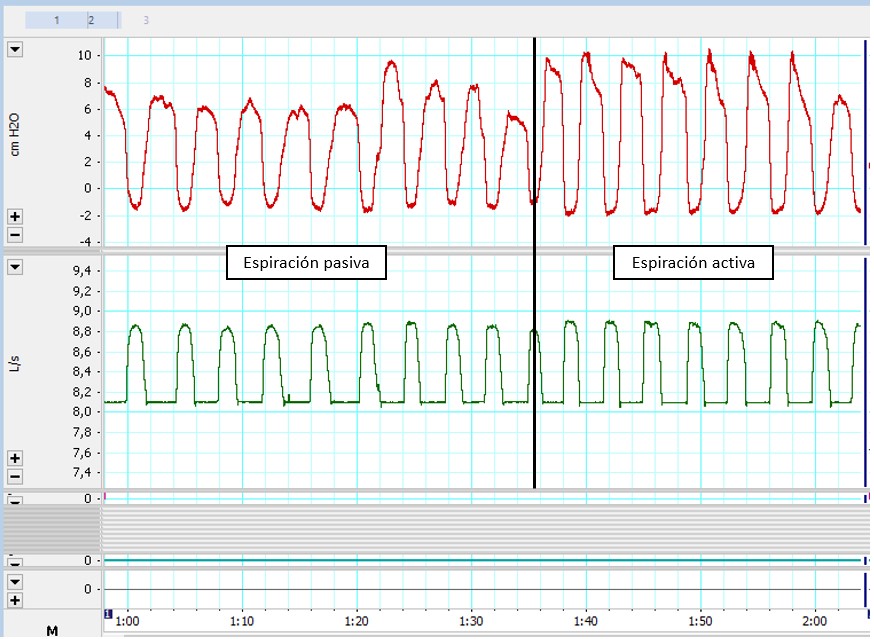
Results with the non-return valve extracted from another mask of the same brand
An outside air leak was identified at the junction of the mask with the skin at the top, just below the air inlet and outlet (see attached figure). At this point, the distance between the skin and the rigid area of the mask is considerably reduced, which means that the silicone does not have the same margin of adaptation to the patient's face. By not identifying any other significant vanishing points, this could be the cause of the pressure loss compared to other full dive mask models.
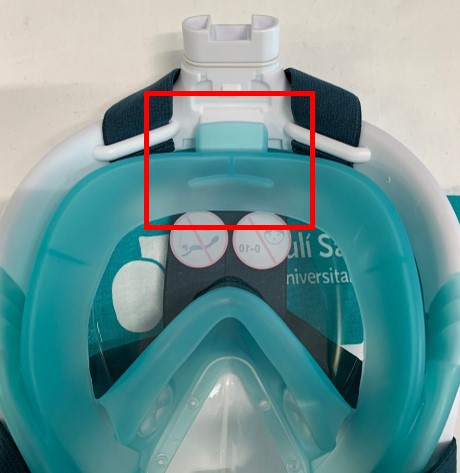
Air leak detection site
- With the non-return valve removed from the inner membrane of the mask:
- In passive exhalation, mean pressures were reached in the final expiration circuit of 7 cm H2O, with a maximum of 8 cm H2O and a minimum of 6 cm H2O.
- In active expiration, point pressures of 10 cm H2O were achieved at the beginning of expiration with a subsequent rapid descent.
As can be seen in the figures from the previous test 1 and this test 2, there are no significant differences between using a valve extracted from another mask and a valve from the inner membrane of the mask. This fact indicates that the non-return valve located on the inspiration pathway is competent enough to fix the effect produced by the double chamber inside the mask.
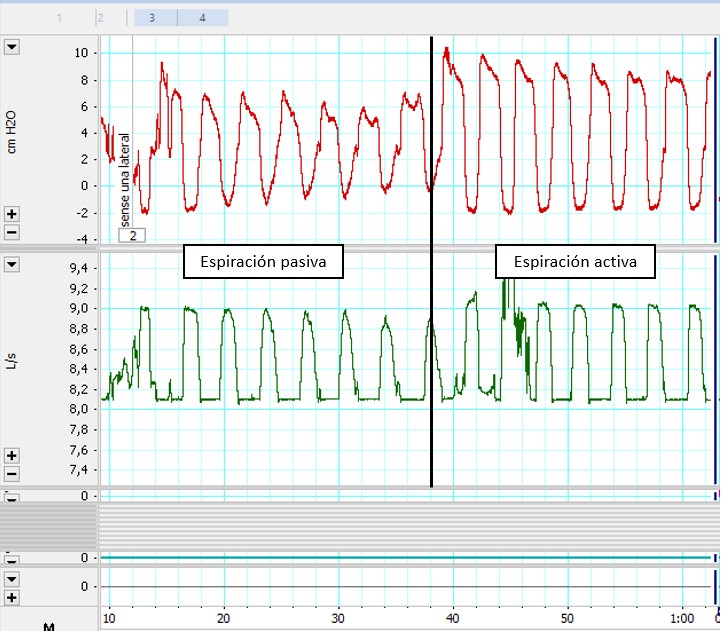
Results with the return valve removed from the inner membrane of the mask
- Without any return valve: The pressures at the end of expiration reached values of 6 cm H2O (4 cm H2O lower than expected). An increase in retrograde flow attributable to the absence of the non-return valve was also detected.
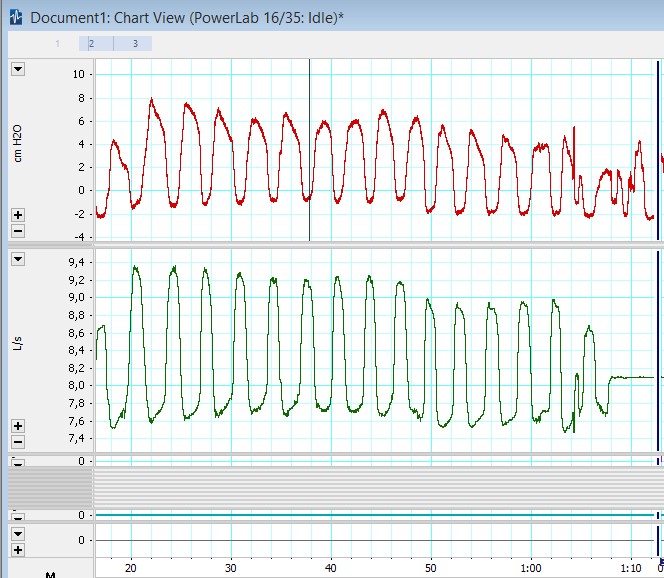
Results without any return valve
PRINT VALIDATION: The clinical utility of this piece has been validated in the Parc Taulí by FDM SLA biocompatible for Class I health product.
PRINTING OPTIONS:
- Material: rigid material (polyamide, PLA, ABS medical, etc).
- Technology: FDM, SLA or SLS.
ASSEMBLY INSTRUCTIONS:
More information available at technical document made by 3D activists, also included in the download files.
The design and manufacture of this product would not have been possible without the participation and delivery of 3D activists, AsorCAD, Dr. Josep M. Serra (Anesthesiology in PHV), Decathlon Spain, Coronavirus Makers.
PART 1 (3DPT033-1)
SK8 Urban "aqua" mask adapter
PART 2 (3DPT033-2)
Support for non-return valve
OPTIONAL: PART 3 (3DPT024)
Only in the absence of the availability of a bactericidal filter. See piece “3DPT024 - Straight Connector 15-22mm for airway tube”.
REFERENCE: 3DPT033
NEED: The need is expected to increase in all hospitals, due to the high foresight of patients who will require non-invasive breathing systems at the peak of the epidemic.
CLINICAL VALIDATION:
- SK8 Urban aqua mask
- 3DPT033-1
- 3DPT033-2 Coupled with Silicone Non-Return Valve Extracted from Mask Inner Membrane
- 10 cm H2O PEEP valve
The system has been validated with the help of external monitoring, using polygraph powerlab 16 SP (Adinstruments Australia) equipped with pneumotachograph S 300 (dead space, 80 ml) and pressure transducer 1150. The two sensors were calibrated against 3L syringe and water column respectively. A 10 cm H2O threshold valve was placed in the expiratory port (Respironics, Murrysville, Pennsylvania). A gas flow of 15L / min was introduced using a Venturi system, with the side openings corresponding to 45% FiO2.
Results:
- With non-return valve: Pressures were achieved in the circuit at the expiration end of 10 cm H2O. The presence of retrograde flow was not observed in all tests.
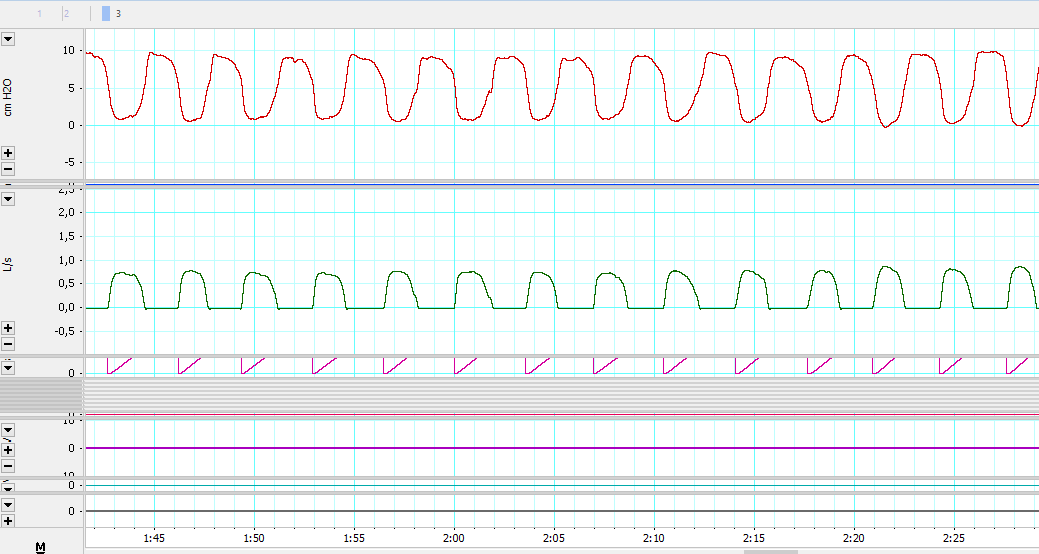
Results with non-return valve
- Without return valve: The pressures at the end of expiration reached reached 6-7 cm H2O (3 cm H2O lower than expected). An increase in retrograde flow attributable to the absence of the extra non-return valve was also detected.
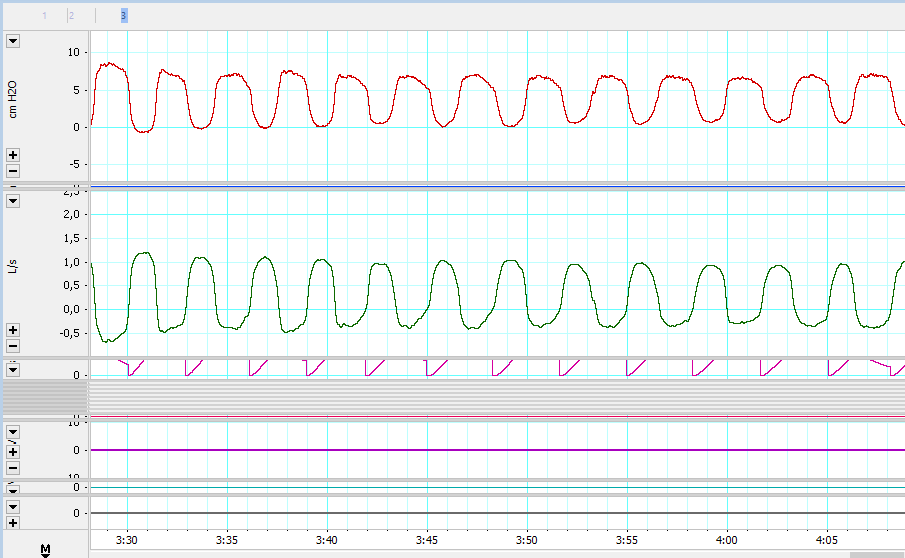
Results without non-return valve
PRINT VALIDATION: The clinical utility of this piece has been validated in Parc Taulí with PA12 printed using SLS technology.
PRINTING OPTIONS:
- Material: rigid material (polyamide, PLA, ABS medical, etc).
- Technology: FDM, SLA or SLS.
ASSEMBLY INSTRUCTIONS:
More information available at technical document made by 3D activists, also included in the download files.
The design and manufacture of this product would not have been possible without the participation and delivery of the Platform Makers Covid, HP and Mediamarkt Spain.



